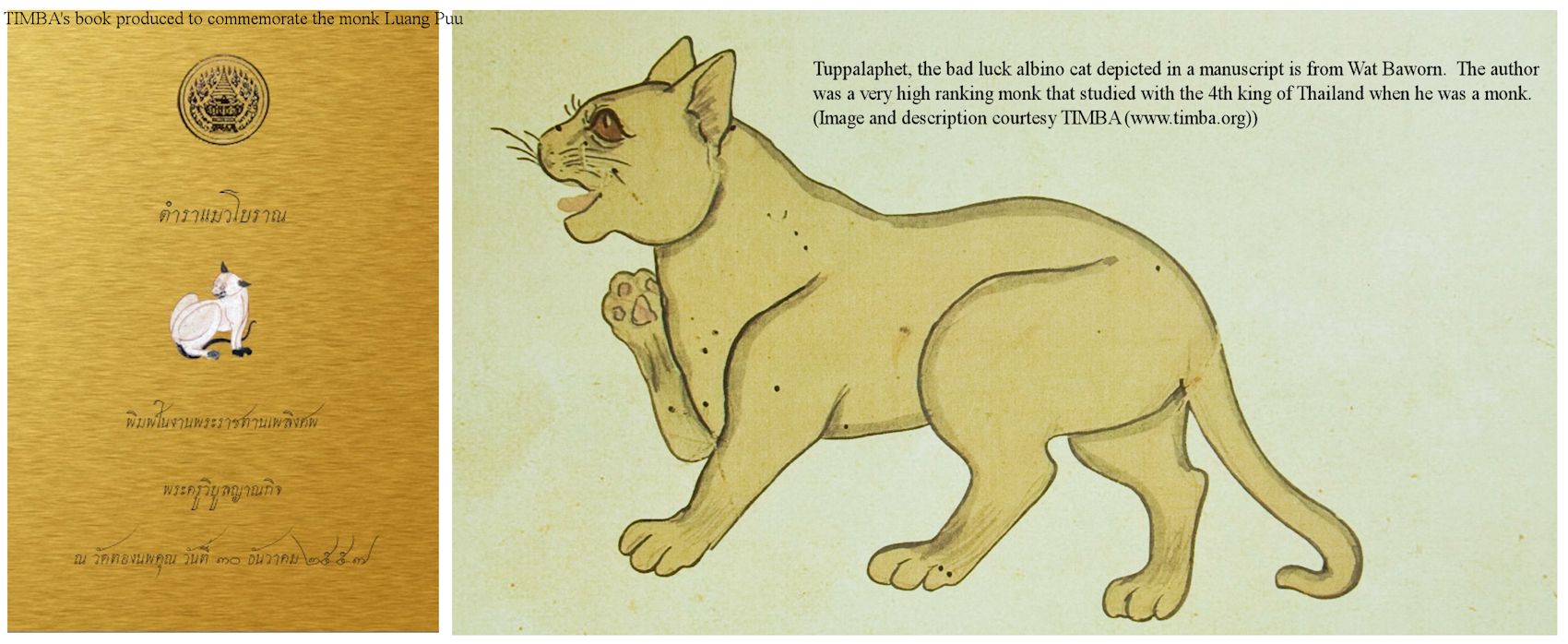
BREEDS ORIGINATING FROM SOUTH-EAST ASIA
Although the ancestors of these breeds were imports from South-East Asia, the breeds themselves have been mostly developed in Britain and North America resulting in cats quite different to those seen in modern Thailand, Burma and neighbouring countries. The Siamese, in particular, has been influential on a number of other breeds, often re-creating cat fancy versions of varieties that occur naturally in its native region!
When reading this, bear in mind that most of the exhibition varieties have diverged considerably from their South-East Asian ancestors! Exhibition varieties are also genetically different from native Thai cats because of early interbreeding with British and American shorthairs. The tubular showbench Siamese and the cobby American Burmese are a long way removed from their moderately foreign Thai ancestors. Some of the breeds described here are not found in Thailand, but created in the west from Siamese and Burmese cats.
THE TAMRA MAEW & SMUD KHOI OF CATS
Before they were known to Western cat fanciers, several Thai cat varieties were described and illustrated in the Tamra Maew and the Smud Koi of Cats. While it is popularly believed that the manuscripts date from the Ayutthaya Period (1351 - 1767) there is no evidence of them existing prior to the early 1800s! Some of the poems may date back to the 12th century, but not the manuscripts themselves. A Samut Khoi (more often found as Smud Khoi in English transliteration) is a folded book; the topic of the book can vary from bird/cat/elephant poems/descriptions to massage methods so Tamra Maew is just one topic of the Smud Khoi. The English transliteration of Thai names is very variable due to the languages'different scripts. The manuscripts were produced by upper class monks, in a Thai temple, in Thailand, but many have been copied and re-illustrated many times over and are basically different editions of the same original document. Some cats varieties are described in the poems, but don't appear in the illustrations.
According to TIMBA, there's a lot of misinformation that has sadly become widespread online. Much of this originates from a story told by Daphne Negus who wrote about the "Smud Khoi of Cats." TIMBA tried to track this particular manuscript down at both the National Museum and the Library. Nobody at either establishment seemed to know anything about it. They did find the old display case at the museum, stashed away on the side of the building, but the manuscript is a copy and doesn't contain a poem. Thus far it is not possible to verify Daphne Negus's story about the alleged "Smud Khoi of Cats." According to her account, a high ranking priest name Somdej Phra Buddhacharn Buddhasarmahathera was commissioned to paint the cat manuscript by King Rama V, Somdey Phra Paramindr Maha Chulakorn (his reign was 1868-1910). Research by TIMBA couldn't track down this monk who should have been famous as his name started with Somdej. A monk with a very similar sounding name was born in 1902, but it's obvious he couldn't have written the manuscript before 1910. The "Tamra Duu Laksara Maew," whose illustrations are widely reproduced online, dates to 1957 and was distributed at Phra Putthajan's funeral.
TIMBA have 23 photos of a manuscript from Wat Baworn which is the "holy grail" of manuscripts: it is complete, the approximate date is known and the author is known have been a very high ranking monk that studied with the 4th king of Thailand when he was a monk. These 23 photos have been reproduced in a small book published by TIMBA in Thailand. Around 100 copies were distributed for free at Luang Puu's Funeral. More were sold a week later and the profit went to buy cat food to help Luang Puu's cats who are still living in his old home today. There is a new monk that lives there now and who is taking care of the cats.

The Tamra Maew describes 17 good luck cats and 6 bad luck cats. Among the 17 good luck cats are the Nin-Rad, black-and-white cats (mask-and-mantle pattern), the Copper (Burmese), the Gao Thaem ("nine marks" - a white cat with black markings on head, neck, shoulders, rump, flanks and front paws), the Dok-Lao (Korat), the Saem-Saert (blue roan salt-and-pepper grizzle), Ratana Kampon (pink), Wichienmas (Siamese), Ni La Chak (black with a white collar). Mulilaa (black with white ears), Grob-wen (white with black saddle and black around the eyes), But-Se-Weis/But-Tal-Lon (black with white dorsal stripe), Kra-jork (a cobby black cat with white around the mouth and copper eyes), Sing-hasep ("lion eater" black with white around the mouth, white nose, white collar and orange eyes), Garn-Waek (black with gold eyes and a white stripe down the nose), Ha-Too-Bot ("four legged" black with white legs and yellow eyes), and the Korn-Ya-Ja (yellow eyed black cat).
It also describes 6 bad luck cats: Tupphalaphet (ruby-eyed white), Phan Phayak or Lai Seua (tiger-striped), Pisaat (rough fur and crooked tail), Hin Thot, Korp Phlerng and Nep Satian (with evil marks (rings?) on its tail). The latter four are illustrated as brown cats.
A more detailed description gives us these cat varieties:
The Wichienmaat (or Vichien Mas) can be identified as the seal-point Siamese. Wichien means "diamond" and mas can mean either "moon" or "gold" depending on how it is scripted, so the name translates as either "Moon Diamond" or, more often, "Gold and Diamonds". The Maew Kaew (Jewel cat) is also identified as the Siamese.
The Supphalak (also rendered Supilak, Supalek) or Thong Daeng (red-gold) which means Copper. The Self Chocolate Asian Shorthair (not the Brown Burmese) is the Western cat fancy s interpretation of this type. However, some Western breeders have chosen to interpret Thong Daeng as Burmese/TOnkinese pointed.
The Korat, Dork Lao (or Doklao), Ma Laid and Si Sawat all refer to the cat known to fanciers as the Korat. Unlike the Siamese and Burmese, the Korat remains little changed from its Thai ancestors. Within Thailand, the Western Korat is considered different to the native Si-Sawat.
The Ninlaret or Nin-Rad (meaning black/dark sapphire/pearl) was said to have black fur, black teeth, black eyes and a black tongue. From later discussion with a traveller to Thailand, it turns out that "Black Pearl" means very dark grey or indigo Korats.
The Ratana Kampon was a pink cat with a band around its body. The description of "pink like the inside of a conch shell" suggests either red shading/tipping or the dilute modifier ("caramel" gene) that turns cream into a pinkish cream called "apricot". It could be an apricot-pointed cat.
The Khao Manee or Khao Plort was a pure white Thai shorthair also called the "Diamond Eye" and described in antiquity, "White Jewel" or "Gold and Silver Eye Cat". Its eyes have a peculiar brilliance. Some have same-colour blue eyes, some are blue/yellow odd-eyed or blue/emerald-green odd-eyed, some have eyes of different shades of the blue. It was said to have been exclusively bred by Thai royalty. There are actually two white cats in the poems. The Khao manee is a good luck cat and is only depicted with a poem in one manuscript out of around twenty manuscripts. The bad luck cat is named Tupphalaphet, and is a solid white cat with red eyes making it a pink-eyed albino cat. This cat is in every complete manuscript as a bad luck cat (perhaps due to the way its eyes reflected light at night time - a reddish glow, not a greenish glow). Because colourpoint is a geneticvariation on albino, a cat matching the description of Tupphalaphet makes perfect sense.
In addition there are the Parort, identified as "steel blue", the Maha Mongkol and the Saem Sawat.
Of all of these varieties, at first only the "freakish" looks of the seal-point Siamese gained the interest of early cat fanciers.
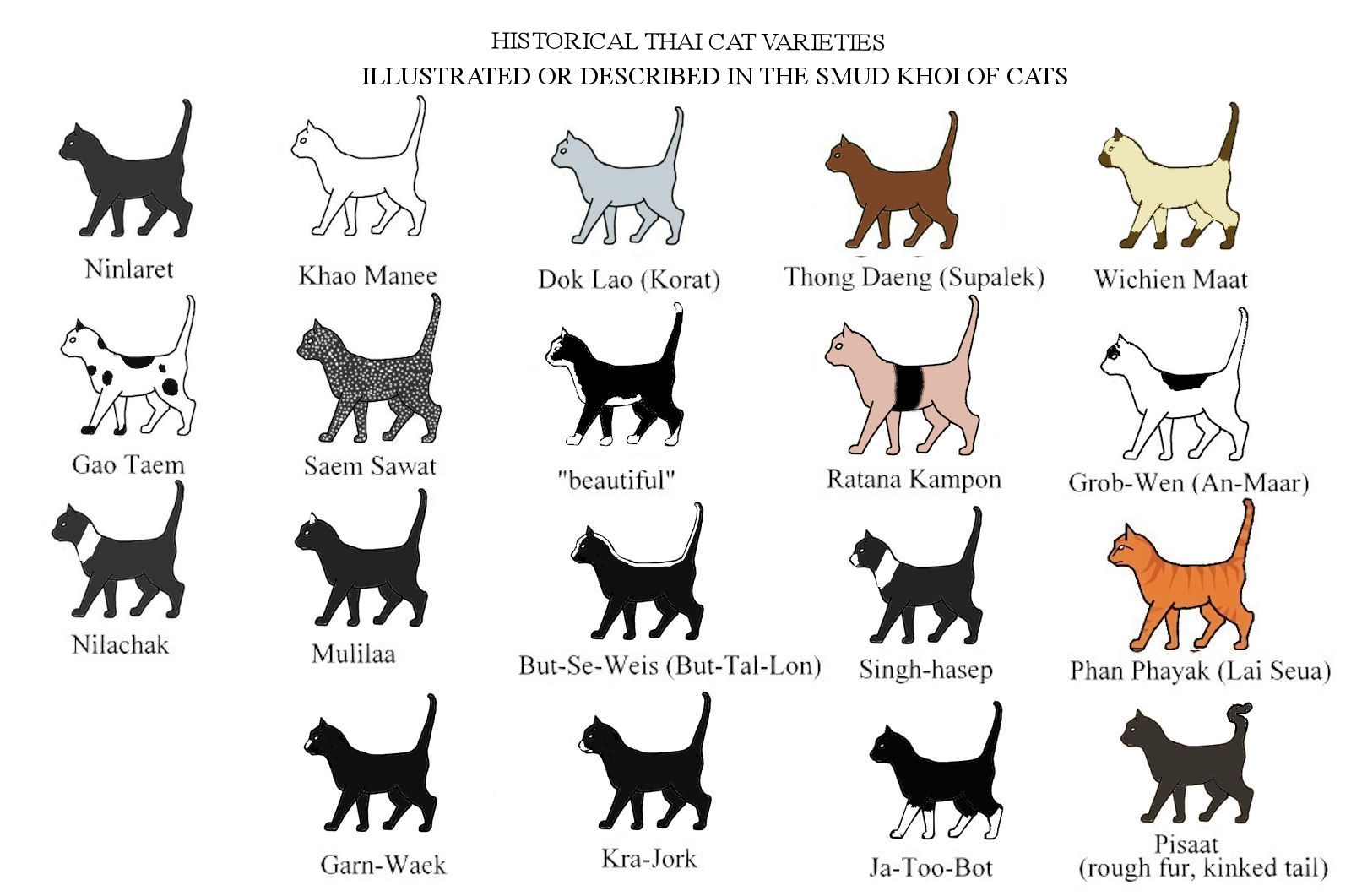
THE MODERN MAEW BORAN
TIMBA (The International Maew Boran Association) now registers the natural Thai cats. Maew Boran (Ancient Cat) refers to the native natural breed of Thai cats. The Western cat fancies refined different colour Thai imports into physically distinct breeds such as the Siamese (with blue eye), Burmese (golden eyes) and Tonkinese (aqua eyes) and have recognised the Khao Manee, Korat, Thai Lilacs and Thai Pointed as different breeds. To Thais, these are all Maew Boran, or Natural Breed, as opposed to a Man-Made Breed. The native Thai cats are also genetically distinct from European/American and Middle Eastern cats. As well as a short coat, many have light-colour coats e.g. blue-grey or colourpoint which may also be an adaptation to a hot climate by reflecting more heat instead of absorbing it. Regardless of the patterns or colours (which the West view as different breeds), they are all related and all have a dog-like personality.
As well as recognising the colours as separate breeds (as logical to Thais as considering the Blue Persian to be a totally separate breed from the White Persian), the Western cat fancies altered the conformation of each colour variant to make them distinct from each other. Siamese come in the elongated, bat-eared, banana-nosed from and a traditional/old-style forms. Burmese diverged into a round-headed American and a moderately foreign European version. The intermediate Tonkinese (also in American and European forms) was considered the misbegotten child of the Siamese and Burmese because it was a cross-breed that didn t breed true for pattern. In the USA, the Havana Brown was developed into something quite different from a solid brown Oriental. Such distinctions would bemuse Maew Boran breeders, because they are merely colourways of the Maew Boran!
Maew Boran in their native Thailand have a mixture of traits and can be seen in every coat colour, pattern and eye colour imaginable, though not all are recognised under a traditional name. The natural Thai breeds are not extreme in the way of the elongated Siamese or the cobby American Burmese. They are all considered colour variants of the Natural Thai Breed and not as individual breeds as they are in the West. In Britain, these would be considered part of the Asian group.
Suphalak / Thong Daeng: the rarest of the Maew Boran colors after Sawem Sawat. It is solid (self) brown without the darker points seen on Brown (Sable) Burmese. The colour tends to bleach to a reddish hue in sunlight. It has the colour, but not the modified head shape of the Havana Brown or Chocolate Oriental Shorthair. In traditional Thai literature it is described as copper-colour or reddish. One of the Thai descriptions of the Suphalek s colour is 'ripe copper' - either the deeper hue that copper takes on as it ages (ripens) or the red of heated copper. The standard used by the Siam Cat Club is based upon the traditional description in the Tamra Maew and calls for an even brown tinged with red or a rust colour (like a tamarind seed), or an even light brown colour. This was difficult to establish in exhibited cats at first. Kamnan Preech had a solid brown stud called "Samsen" but it proved hard to reproduce his solid colour and eliminate the cb (Burmese colour restriction) gene from the gene pool. In 2013, a solid brown stud called Ayothaya was acquired from a temple in Bangkok. DNA testing showed he didn't carry any colourpointing or dilution genes. The Suphalek foundation programme is now based on Ayothaya and other natural breeds: Konja, Thai Burmese, Chocolate Point Wichienmaat and Lilac Korat. A single Suphalak female called Thonga was exported to the USA where she is lost to the Suphalak breeding programme, but is contributing to the gene pool of Traditional-style Oriental cats (Tibetans). Although Thonga has been bred to a Western Siamese cat (which is a long way removed from the Thai Siamese cat), Young does not consider the cats descended from Thonga to be "Western-style Orientals." Thai breeders would not consider them to be truly Thai cats. It is similar to the story of Wong Mau, the found of the Burmese breed with outcrossing right from the start, resulting in cats dissimilar to their Thai ancestors. Thais are wary of allowing their native cats to be exported overseas, bred to Western cats and made into a Western breed that claims a right to the original Thai variety name.
In the poems, the eye colour was compared to pomegranate, or Ruby. This brings to mind the reddish glow of eyes that lack a tapetum, however the iris colour the yellow-gold of a pomegranate rind. [There is a "pink-eye dilution" mutation that gives both a yellowish iris and reddish glow, matching the description of the eyes, but this mutation gives a bluish-tan coat colour.]
In January 2015, I received information and photos of a native Thai cat that TIMBA hoped to use in the Suphalak breeding programme. Nolan lives in Thailand and is working on the breeding project to resurrect some of the rare cats that are described in the ancient cat poem manuscripts. Breeders are currently working on the Suphalak, which is a solid chocolate self - basically the natural breed equivalent of the Havana Brown/Chocolate Oriental SHorthair. Breeders have been searching all over Thailand to find cats suitable to be used in the breeding program and found this cat, Mai Thong, aged approx 7 months, on the street. Nolan hoped that she was either cinnamon (although cinnamon has not been identified in Thailand's native cat population) or lilac. DNA was tested at UC Davis and came back as aa BB CC DD, which should produce a black cat. However the cat is very obviously not black, but has an orangey colour which is suggestive of a non-extension gene since a similar colour exists in the form of the Russet Burmese (though Nolan doesn't know what colour Mai Thong was when born).
Thai breeders have been trying to breed a solid brown cat for a long while, but without a solid brown cat to start off with, it is very difficult as they needed to isolate the recessive chocolate colour from solid black and sable Burmese cats. A Korat breeder who may have been trying to recreate the Suphalak almost managed this because some of her exported Korats produced lilac kittens and lilac is the dilute of chocolate (these went on to become Thai Lilac in Europe). Unfortunately any known chocolate-carrying lines were lost in their native Thailand. Within the last 10 years, only the solid brown "Samsen" was found. Preecha bred Samsen and got only solid black cats (Konja) or pointed Burmese. He didn't realise that the solid black cats carried the recessive chocolate gene. The closest he has managed to a Suphalak are strikingly attractive low-contrast pointed Burmese (cbcb BB DD). The retired breeder Khun Aree Yoobamrung also never achieved the solid brown cat, but he dubbed his Thai Burmese "Suphalak" and this unfortunately led to the Western cat fancy believing that Suphalak and pointed Burmese were the same. For nearly a decade Samsen was the only known Suphalak in Thailand. With TIMBA's help, there are now 3 male Suphalaks (a father and his 2 male offspring) and 7 females; the came from all over Thailand, but unrelated males are needed to keep the gene pool healthy and diverse. An American breeder who spent some time in Bangkok acquired and exported one Suphalak female, Thonga, who was bred to a traditional-style longhaired Siamese that carries chocolate. The breeder hopes that Thonga's descendants will produce solid chocolate Oriental Longhair kittens and pointed Tibetans. Because the Western Siamese is a long way removed from its Thai ancestors, the offspring are not fully Thai cats. True Thai cats do not have fluffy coats or long hair a adults. Ayothaya was discovered after Thonga and was deemed a chocolate Suphalak.
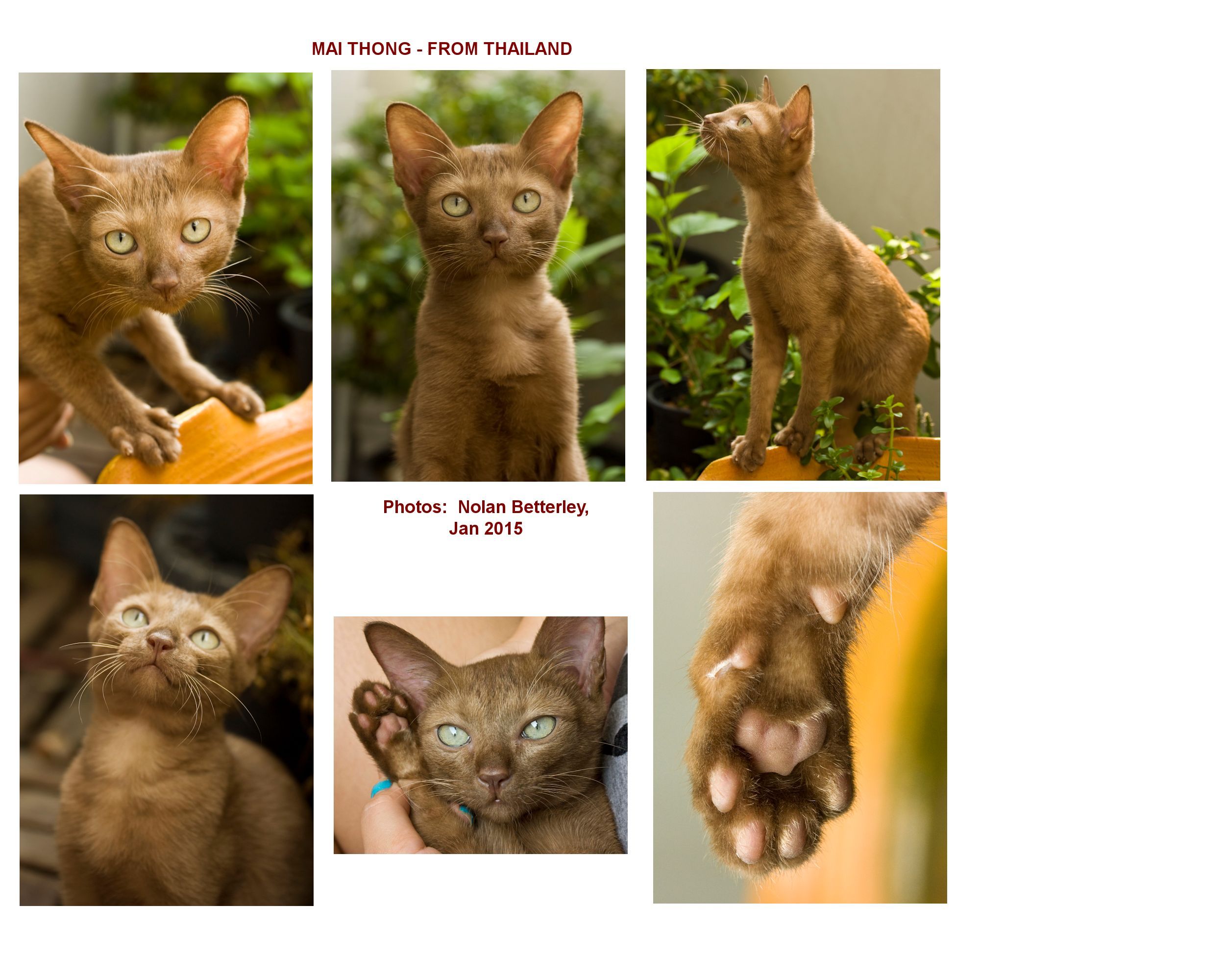
Konja / Ninlarat: the natural Thai black cat with golden eyes and this is a common colour in native Thai cats. The black is an intense, glossy hue compared to onyx or black ink. According to the Tamra Maew description the Ninlarat had black eyes, teeth, claws and tongue. As this probably only occurs in the medical condition porphyria, the terms Konja and Ninlarat are now used interchangeably for black Maew Boran, though the original Konja had a white stripe from under the chin, down the chest, along the belly and ending between the thighs (sounds like a tuxedo pattern). The white stripe is overlooked in the modern Konja. The Bombay is the analogous breed in the West; the European Bombay (Black Asian Shorthair) being closer to this black Maew Boran than is the cobbier American Bombay.
Si-Sawat / Korat: a blue grey cat and is rather rare in Thailand. In the natural breed, the eyes can be yellow or green. Lighter colour kittens are also found in the natural breed and are analogous to the Thai Lilac and Thai Blue Point of the European cat fancies.
Wichienmaat / Natural Siamese / Thai: Only the Seal (dark brown) point Wichienmaat is intentionally bred by Thai breeders, though chocolate, lilac and blue point can appear due to recessive genes. Because the cats naturally interbred with other colour cats, there are naturally occurring red points, tabby points and tortie points, however, only the seal point is selectively bred and recognised as the Wichienmaat. The Tamra Maew didn t specifically mention the intense blue-eyes seen in Wichienmaat. Most of the manuscripts the eye colour is compared to an emerald, an aqua color. In one manuscript the eye color is compared to the body color of Naga. There are several different royal family Naga described in Thai mythology, one of which is Erapatha Naga, and is believed to have a green body. Although there is no mention of blue eyes in any of the manuscripts, today's Wichienmaat breeders prefer light to intense blue color eyes. The hotter climate restricts the colourpointing to smaller areas than seen in many Western Siamese.
Khao Manee (White Jewel): This is the solid white form of the Thai Natural Breed and can have blue, yellow or odd eyes. It has recently been bred in the West as well. In the Tamra Maew it is called Khao Plort (Solid White) and the eyes are compared to a diamond (sparkling, but with no reference to actual colour) which has sadly led to some white pet cats with glaucoma been prized, rather than getting veterinary treatment. Other descriptions referred to mercury-coloured eyes, probably the silvery-blue of the metal, which was well-known in ancient Asia. For a long time its closest Western equivalent was the White Aisan Shorthair, but the Khao Manee is now being bred in the USA. The modern Khao Manee is small white shorthaired cat with eyes of blue, gold, green or odd eyed (one blue eye and one either gold or green). They are lighter in build than cats of western origin, but not as light as the modern exhibition Siamese. They are people-oriented, intelligent, active and playful and often play games of "fetch" or present a favourite toy when wanting attention.
Bangkok (Wila Krungthep) also known as the Mocha cat, this is a pale brown mocha coloured cat with blue or light aqua eye. It appears to be an incompletely co-dominant mutation of the gene that causes Siamese and Burmese colour restriction. This means that intermediates between Bangkok and Siamese (Wila KrungSiam, Siamocha/Si-mocha) and between Bangkok and Burmese (Wila KrungSri, Bur-mocha) can be bred. Although not specifically mentionedin the ancient texts, it is a natural Thai colour mutation. The first Wila KrungThep identified in Thailand was named Mai Thong ("golden silk") because of her unusual light golden looking coat. The colour of the Wila KrungThep is therefore called Si Mai Thong or "the color of golden silk."
Wila KrungSiam (Siam Cat, Sia-mocha) resembles the Wichienmaat.
Wila KrungSri (Ayutthaya Cat, Bur-mocha) is intermediate between the Bangkok and Burmese, with one Bangkok allele and one Burmese allele. "Wila" comes from an older version of the Thai language and means "cat." KrungSri, or Ayutthaya, was the former capital of Thailand. There is no poem in the Tamra Maew that describes this colour. The closest is the Suphalak, or Thong Daeng, but that should be uniform brown without the pattern seen on "bur-mocha" cats. Likewise, Wila KrungThep translates to Bangkok Cat. It is not described in the Tamra Maew.
Thai Burmese / Natural Burmese: These are analogous to the Brown (Sable) European Burmese with the darker points. In Thailand, the eye colour ranges from gold to light green and the coat colour ranges from milk chocolate to dark chocolate. The only difference between Thai Burmese and Suphalak is that the Suphalak does not express the cb gene.
Thai Tonkinese: In the west, the Tonkinese was created by crossing Siamese and Burmese cats although Wong Mau, the mother of the Western Burmese breed was a Tonkinese herself. In Thailand, this in-between colour is common in the Natural Breed and is one of the most common Maew Boran cat colours and this type is represented in the West by the European Tonkinese. It does not appear in the Tamra Maew and is not intentionally bred by breeders in Thailand. In ancient times it may simply have been considered a slightly darker Wichienmaat or a lighter Thai Burmese.
Thai Tabby, Tortoiseshell and Patterned Cats: Though common in the Natural Thai Breed, in dense and dilute forms, both with and without white, many of these are not mentioned specifically in the Tamra Maew. Their eye colours are related to the coat colours and to the presence of colourpointing genes. Unlike their Western pedigree derivatives, native Thai cats don t discriminate against each other on the basis of colour and produce every possible colour and pattern combination.
Saem Sawat: though not on TIMBA's list, white-speckled black (roan) cats have been found in Thai street cats, but thus far, they've all turned solid black. In those cases, the roan colour was "fever coat" caused by stress or illness. There are photographs of grizzle-coated adult cats, but none have been bred recently. Black cats are extremely common in Thailand and many temple cats are black; this is why there are so many black-and-white varieties described in the Tamra Maew. Unfortunately Temple cats live a rough life and most kittens get sick. The pregnant females also get sick, often giving birth to kittens with fever coat that later turn solid black (if the kitten lives to adulthood). Two breeders, Suphat (currently) and Khun Aree Yoobamrung (in 2005, now retired) acquired Saem Sawat looking kittens for breeding, but in both cases the cats turned solid black when they got older. A black kitten born in the Suphalak breeding programme became extremely ill and developed "fever coat" which persisted for several months before turning black again. US-based breeder Lisa Young claims that the Saem Sawat's coat remained speckled into adulthood and points to Martin Clutterbuck's images of (young) adults with speckled coats. If the speckled coat does persist past the first moult and into later life, this would make it a rarer colour/breed than the Suphalak and analogous to a tweed/roan mutation.
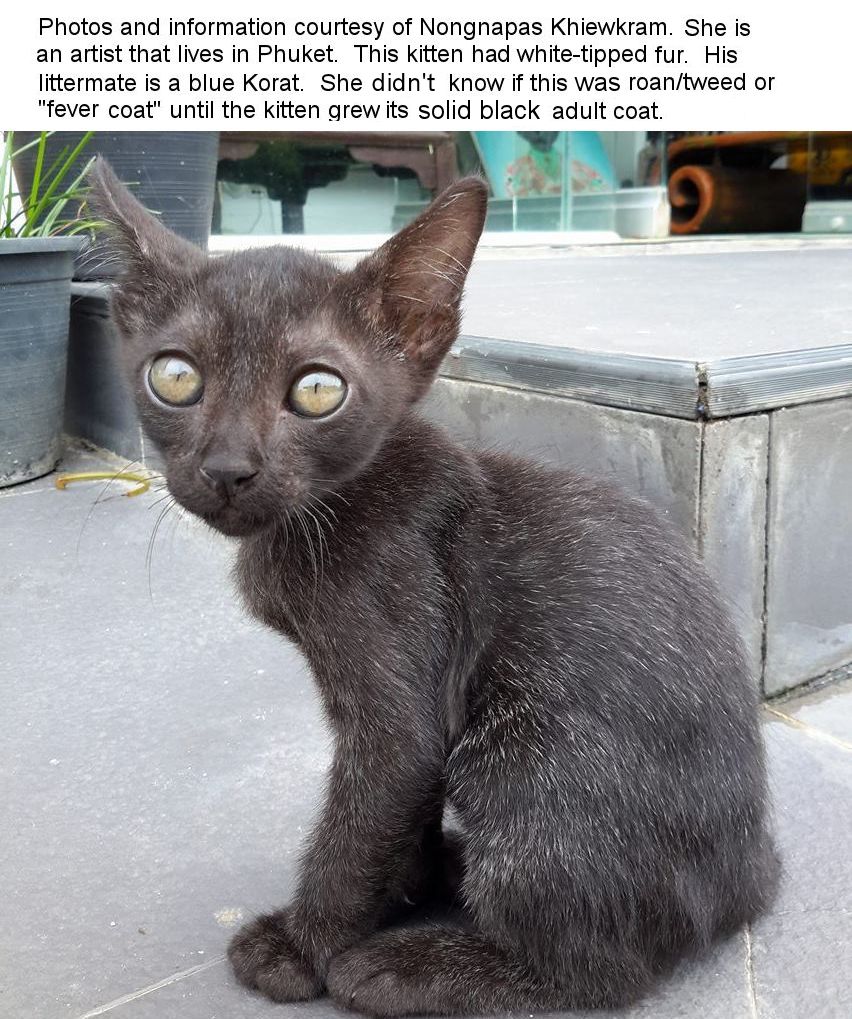
PRESERVING THE MAEW BORAN
Western cat-lovers visiting Thailand will notice that the cats there don't look anything like the Siamese and Burmese they are used to seeing in the West. The native Thai cats could not be registered in the West because they had already been taken by Western breeders and turned into something quite different - the Siamese had become elongated and the American Burmese had become cobby. There was the perceived threat of Western breeders "stealing" yet another Thai Maew Boran colour and turning it into a breed (with a price tag for its novelty or rarity) that didn't resemble the original Thai cat at all.
In Thailand, there is a single conformation. What Western breeders think of as "breeds" (Siamese, Korat etc) are just colour varieties of the native Thai cat. The different colours can be freely crossed and then given the name of their phenotype: Wichienmaat for colourpointed, Korat for solid blue, Suphalak for solid brown etc. Crossing any of the varieties with a Khao Manee gives a whole litter of Khao Manees, but the offspring's descendants could revert to being Konja, or Ninlaret or whatever! The separation of the these variities into "pure breeds" in the West is illogical to Thai breeders, but is deeply entrenched in (and insurmountable after a century or more) the Western cat fancy. Some Thai varieties do have special characteristics that Thai breeders preserve through selective breeding. The silver tipping of the Korat is preserved by mating Korat-to-Korat, however it's seen as perfectly reasonable to use a blue point wichienmaat in a Korat program. Any colourpointed descendants are simply not called Korats! Technically they are not Wichienmaat either, as only the seal-point is recognised as a variety.
In Thailand, the blue-pointed offspring and the lilac offspring are not worth as much as they are not traditional colours recognised in the Tamra Maew. With no association governing what varieties can be bred together, an unrecognised blue-colourpoint can be crossed to a Wichienmaat (seal point by definition) ato produce seal point Wichienmaats. But the carried recessive blue colour may re-emerge to surprise a hobby breeder further down the line. A Thai Korat breeder experimentally bred a Korat to a Wichienmaat and got a Konja (black cat). In general, Konja are not sold so they aren't deliberately bred, but some breeders like to keep a perfect Konja as an example of the variety. The Konja was bred to a Korat and produced a mixed litter of Konja and Korats. When this happens, if the Korat offspring Korats are good quality, the breeder will consider further crosses with a Wichienmaat. Oddly, one of the few Western registries that use a similar philosophy is the "paper registry" REFR that registers the "Lynx" breeds according to phenotype, not according to ancestry. The conventional registries do this in only a limited way e.g. Abyssinian/Somali, Exotic Shorthair/Persian and the traffic is generally only one way.
Because Thai breeders are preserving cats that match descriptions in the Tamra Maew, they often bring in random-bred cats that match descriptions in the Tamra Maew. These cats often bring along recessive genes. This is anathema to those used to Western cat fancy rules, where foundation cats (cats of known ancestry) are used only under special circumstances and with restrictions on the registration of their offspring. Thai breeders are working with a natural breed and not with cats that must be bred like-to-like for 5 (or 8) generations in order to be considered pure-bred. Pedigrees are important to prevent inbreeding, but a Thai Korat's cat's ancestors may include Konja, Wichienmaat etc and not be limited to Korat. While Western cat fanciers may cry "it's just a moggy!" they've lost sight of the fact that all fancy breeds descended from moggies, and that the Thai cats are the original article before Western fanciers changed them beyond all recognition based on aesthetic whim.
Regarding pedigrees, at present many Thai breeders don't use a system anything like GCCF, TICA, FIFe or CFA. They can usually document 3 generations. It is hoped that the profile and value of Thai natural cats can be raised (and compete with imported breeds) by including more formal pedigrees (that would, or course, record crosses with other Thai varieties). This "crossing" is why Western Korats have produced lilac and pointed variants. These aren't a sign of genetic impurity, but of a different breeding philosophy in Thailand. Preecha's Korat breeding programme included blue Burmese-pointed cats and blue Tonkinese-pointed cats (cbcb dd & cscb dd) cats bred from Korat parents. The hot temepratures in Thailand meant they showed minimal pointing and were just a shade lighter than a solid blue Korat. They also had excellent silver tipping to their fur. These were bred to genetically solid blue Korats and produced offsprting that were Korats, but carried a colourpointing gene. Many of those cats were exported and in later generations those recessive genes showed up (in addition, some wartime breeders were forced to cross Korats and blue-point Siamese just to keep the breeds alive).
Maew Boran is registered as an experimental breed with TICA, but it will be TIMBA that manages and controls everything... The western cat fancies are not good at managing natural breeds as they are interested in exhibition cats, rather than preserving natural breeds with a diverse phenotype that don't (in Western eyes) "breed true." Although blue-points and tortie-points aren't Tamra Maew colours, they are still native Thai cats and are important for the health of the Maew Boran and may be popular abroad. With such a small Maew Boran gene pool in the USA, the unrecognised colours are essential to maintain diversity and reduce the temptation to outcross to the fancy Siamese or fancy Burmese. The Maew Boran is a very old breed, but is new to the international cat fancy. It provides an alternative for breeders;to breed a natural breed native to Thailand and not be worried about crossing colour varieties. There is, of course, a horrible feeling that the Western cat fancy will end up with a breed it calls "Thai Shorthair," formally recognising non-Tamra Maew colours and having breeding policies that conflict with those in Thailand ... which would put us back at square one.
Unfortunately we run into the sort of politics that have beset the cat fancy from its earliest days in England. The Facebook-based US-based Thai Cat Fancier's Club of Thailand (TCFC) promotes knowledge of and appreciation for historical or auspicious breeds of Thai cats and advocates their conservation, preservation and recognition. However, following web links, TCFC is part of Young's Thai Dee Maew Cattery which breeds Tibetans (Suphalak x Western Siamese) rather than pure Suphalaks and is in line with the cattery's views and opinions rather than native Thai opinions ("anyone can start a club"). In addition to TIMBA (Thai-based), TCFC (US-based) there is The Thai Cat Center (US-based, Doug Schar). While TIMBA considers the Konja and Ninlarat as one type, TCFC considers these to be 2 different types based on the Smud Khoi. The Thai Cat Center separates the Suphalak (non-pointed) and the Thong Daeng (Burmese and Tonkinese patterns, well known in the West, but not held in high regard in Thailand). According to Young, the Thai government's export office dictates what breed any exported cat is, for example they consider the native Si-Sawat and the Western Korat to be separate (and this is correct). Export offices sign off export licences based on evidence presented by the exporter.
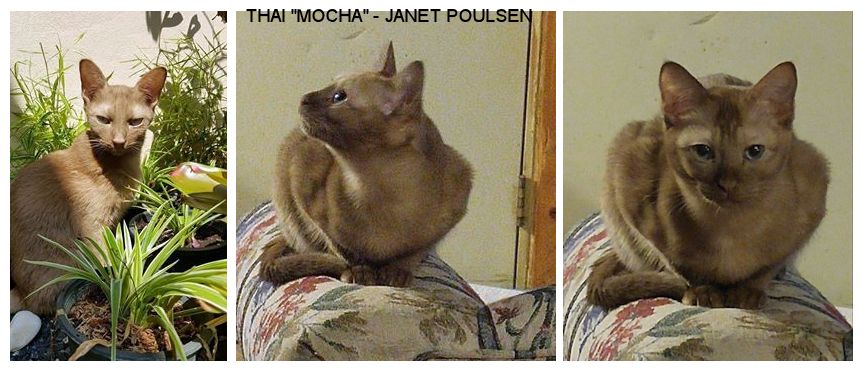
In April 2016, Janet Poulsen announced a new Thai colour to be imported into her breeding programme in Minnesota. It was speculated that the colour, called Mocha, is in the albino series (tentative symbol cm). If it was not on the albino series, there would be the possibility of some non-black kittens. Mating a lilac boy (CC bb dd - non-pointed, black, dilute) to the imported mocha girl (cmcm BB DD - mocha, black, non-dilute ) established the new colour gene to be on the albino series and fully recessive to C (non-pointed) by producing solid black kittens. Colour tests avaiable at the time indicated that the mocha girl was CC, meaning she should be a black cat. She looked like cinnamon but was not (genetically).
Homozygous mocha (cmcm BB CC) is a light tan/blonde color. The coat appears almost ticked, as the individual hairs are very light at the base and have a darker band near the tip. The brow region is very light and there is very minimal darkening at the extremities (unlike colourpoint). The nose leather and paw pads are pale, but not pink. Homozygous mocha cats appear to become lighter in color during their first year, perhaps due to the very light colored coat base. The eyes are blue. Of the 2 Mocha cats born in the USA (by 2016), the female had slightly aqua-tinted eyes and the malehad ice blue eyes.
In addition to the mocha colour there are some Sable (Brown) Burmese cats with blue eyes. Colour tests indicate that the blue-eyed sable Burmese cats are genetically black. So far, a mating of two cbcm (tests as Ccb because there is no test yet for "mocha" cm) cats produced one cbcb, two cbcm (Ccb in tests) and two cmcm (CC in tests. The cbcm (Ccb) kittens are lighter in color than the cbcb, but still pointed and within the normal color range for Burmese cats. The cmcm (CCin tests) kittens are significantly lighter and though perhaps a bit darker on the nose, they are lighter around the eyes.
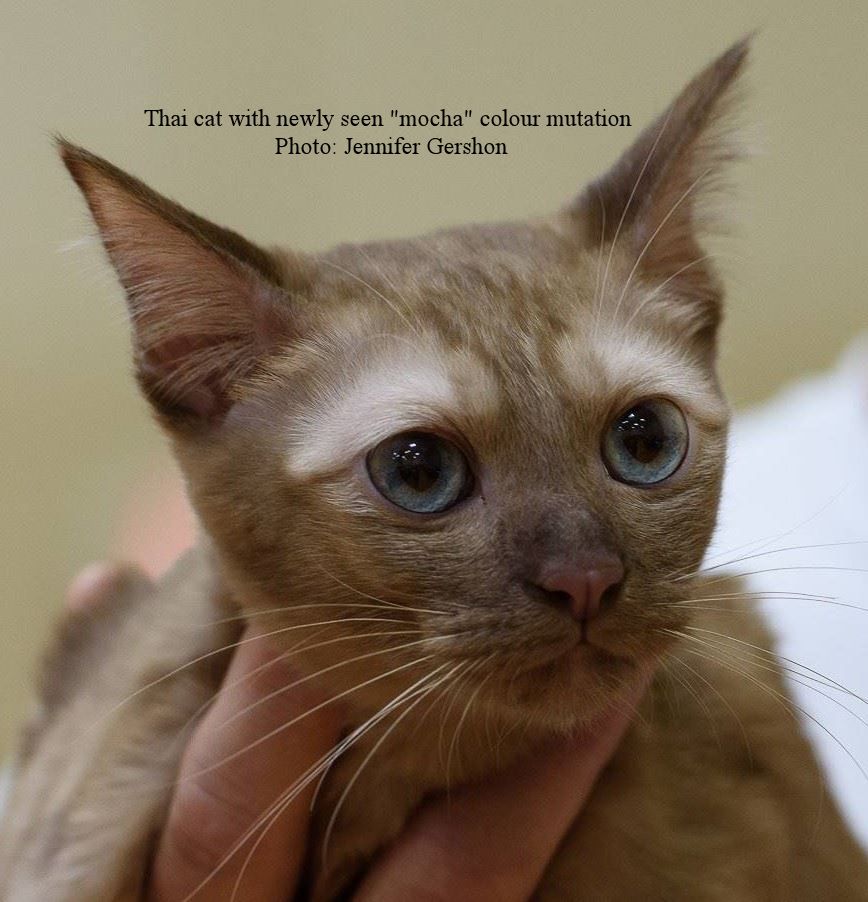
CLASHING CULTURES IN THE CAT FANCY
To ensure impartiality I am including another view of Maew Boran recognition. Is it preserving native Thai cats or a marketing them to the Western cat fancy? Despite criticism, TIMBA does work with Thai breeders of the different cats, but gives descriptions of them in terms Westerners understand. In some cases, TIMBA (in consultation with Thai breeders) needed to find a name for colour variations considered commonplace by Thais, but unfamiliar to Western cat fanciers.
Some Thai cat lovers complain that TIMBA and The Thai Cat Center were founded by, and are run by, non-Thais who have invented the Maew Boran breed. In Thailand, government recognition is extremely important for most ventures so it is significant to Thais that the term Maew Boran is not recognised by the Thai government, and that TIMBA and The Thai Cat Center are not recognized by a Thai government body. Thai cat lovers wonder why an organisation interested in preserving ancient and revered breeds of Thai cats lumps them all together in a manner contrary to the normal ways of doing things in Thailand. At the same time, Western cat fanciers are at a loss to understand how Thais classify these cats.
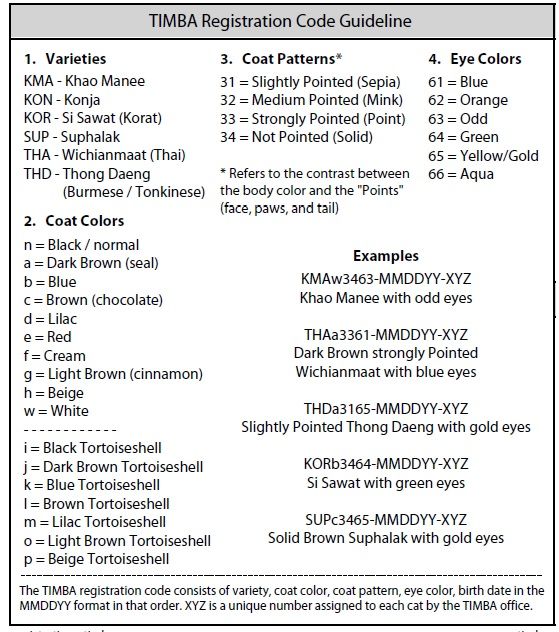
Another issue for Thais is that TIMBA only registers a small subset of cats from the Tamra Maew but includes cats that are recognised by Westerners, but are not in the Tamra Maew e.g. Thai Burmese, Thai Tonkinese, and tortoiseshells and mixed patterns. In Thailand these are "Baan Maew Thai" meaning common Thai cats without any special significance, and they are not specifically bred. This is an issue of different recognition cultures in Thailand and the Western cat fancy. Westerners don t understand the subtleties of auspicious or inauspicious colours and patterns, they need a named breed as basis of recognition, then the colours/patterns are defined for each breed. The colours and patterns popular in the West do not figure in the Thai books describing revered cats. There will always be a clash. Even if a formal Maew Boran breed standard prohibited torties and tabbies there will be breeders wanting to expand the palette, as has happened in the Western Siamese and Burmese. While Maew Boran may be an invented term, it aims to protect traditional Thai varieties (including the Baan Maew Thai types) from being Westernized in the same way as Siamese and Burmese.
It is often important to add outcrosses to Western breeds that have low genetic diversity. Breeds from the original country of origin are preferred even though the Western version may have diverged significantly from its ancestor. This raised the concern that the progeny of "Maew Boran" cats crossed to modern Westernised versions (Korat, Burmese etc) could be registered with a TIMBA pedigree showing 100% Thai origin, rather than 50% Western origin. Genes from the Westernized versions should not be allowed to creep into the Maew Boran gene pool.
OTHER UNUSUAL COLOURS IN THAI CATS
In 2017 Lori Snook Haas posted a series of photos (used in the genealogy chart here) of a "putty coloured" female that should have manifested as a red-tortie. Instead she was visually cream, but did not have the dilution genes to genetically cream. She also had no black markings anywhere on the surface (including paw-pads, gums and palate of the mouth). It is possible that there are other Thai colour mutations emerging now that the cats are being selectively bred.
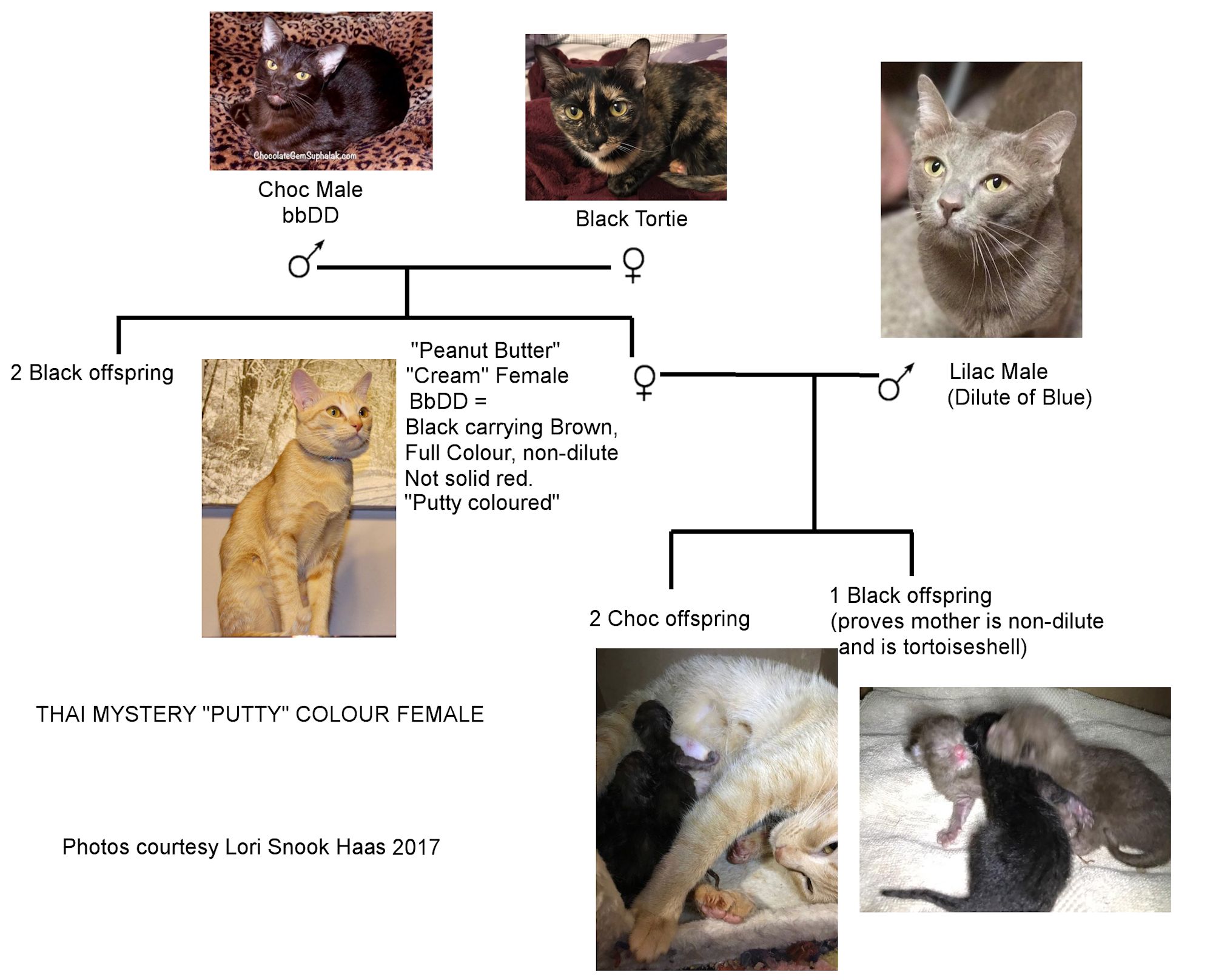
There are possibly other modifier genes in the Thai cat population that affect the distribution of whte spotting. Cats with white dorsal stripes are seen occasionally, and black dorsal stripes are depicted in Thai art and seen in the cat population.
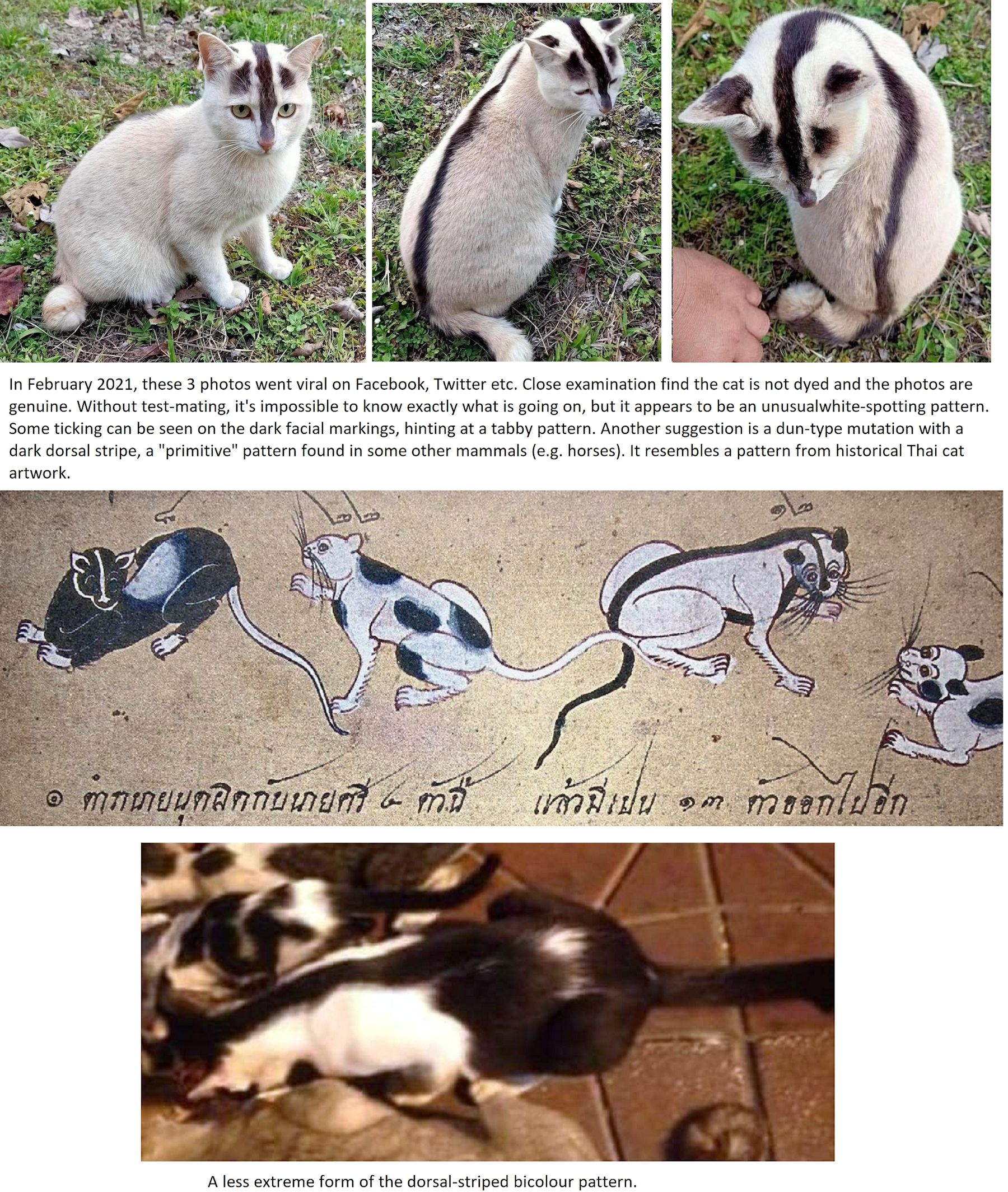
EARLY IMPORTS INTO BRITAIN
The Royal Siamese (seal-point), Chocolate Siamese (possibly equating to the modern Burmese or Havana), Blue Siamese (Korat) and Burmese (the photo shows an Oriental Ticked Tabby) all made it to Britain during the late 19th and early 20th Centuries.
The Seal-Point Siamese was claimed to be the pet of royalty and was known in Britain as the Royal Siamese. The chocolate coloured cats were said to be "Temple cats" or "Rajah type". They had the same standard of points except the chocolate cats had a dark rich brown body colour which made the markings less noticeable (modern Burmese pattern). Early cat fanciers also imported Siamese with "coats of burnished chestnut with greeny-blue eyes" (possibly mink-pattern i.e. Tonkinese type) and "chocolate coloured Siamese with the same colour all over" (possibly Havana type). A "wholly chocolate-coloured strain of Siamese" were exhibited in 1894 as Swiss Mountain Cats. The chocolate colour cats, along with a few other variants that cropped up, vanished in the 1920s when the Siamese Cat Club ruled that only blue-eyed "Royal" Siamese were acceptable for registration.
Later in the 20th century, some of the varieties found naturally in their home region were re-created through outcrossing Siamese and Burmese cats to domestic shorthairs. Or to be more accurate, the colours were re-created, since selective breeding had changed the conformation so that the show-bench cats differed greatly from their Thai ancestors. It s important to remember that the breeds detailed below are the Western cat fancy versions of South East Asian varieties.
SIAMESE AND AMERICAN COLORPOINT SHORTHAIR
The Siamese was one of the earliest breeds recognised by the Western cat fancy and is still one of the most recognisable breeds. Early imports often had a kink in the tail. Some believe it resulted from crossing the sacred cats of Burma with Annamite cats when the Siamese (Thais) and Annamese (Vietnamese) conquered the Khmer empire. The pattern is properly called "colourpoint". It is represented in early manuscripts as the "Vichien Mas" or "Wichien-Maat". Other varieties considered ancestral to the Siamese include the Singhasep, Annamese, Laotian Lynx and Gould's Cat. Its distinctive looks and voice even led some early 20th century fanciers to claim it was the product of crossing domestic cats with, variously, the Indian (Yellow-throated) Marten, the Civet, the Bay Cat or Temminck's Golden Cat (Asian Golden Cat) or with some type of Asian viverrine unknown to science.
Although the original colourpointed cats came from Thailand, the exhibition breed was developed in the UK and USA. During the British exploration of Asia in the 1800s century, it was common to bring back curious creatures. The early Siamese shocked a cat fancy that was accustomed to the round headed and heavily built Persians and British Shorthairs. Siamese cats exhibited at the Crystal Palace Cat Show in the early1870s were considered "ugly" and "frightening" by many. These early imports were apparently not bred. In 1878, the wife of American President Rutherford B. Hayes received a Siamese cat as a gift from the American Consul in Bangkok, the first documented Siamese in the USA, but again it was not bred.
The first breeding Seal-Pointed Siamese were imported in 1884 and exhibited in at the Crystal Palace in 1885. The only acceptable type was the Seal-point or "Royal Siamese". Blue-Pointed and Chocolate-Pointed Siamese occurred naturally in litters due to recessive genes in the 1890s, but were dismissed as freakish cross-breeds. An early champion, "Wankee", bred in Hong Kong in 1895 was allegedly the offspring of a female kitten stolen from the King of Siam s palace. Early judges also encountered, and dismissed, a chocolate variety that later became the Burmese.
The myth that the Siamese cat was reserved for royalty was debunked by the Zoological Society (Britain) in 1900, but cat-fanciers and zoologists either didn t talk to each other or, more likely, cat-fanciers preferred the myth of a royal cat to the reality of a common cat. In the Proceedings of the Zoological Society, April 3, 1900 is a report entitled "Mammals of Siam and the Malay Peninsula" which reads: Felis domestica Briss. The Common Cat. " Kuching" of the Malays. " Mow " of the Siamese. The ordinary domestic cat of the Malaya has a very short twisted or knotted tail, or else a mere bob. In Johore I have seen a very remarkably coloured variety of cat, somewhat like the English "tortoise-shell," but the different colours arranged more in spots than in blotches. The "Siamese" cat is fairly common in Siam, and not "reserved for royalty" (Lydekker, Royal Nat. Hist. i. p. 429, line 7). In Bangkok and the Straits Settlements it is not so much prized as a domestic pet as is the somewhat similar, but darker coloured, "Laos" cat from Northern Siam. In this region as elsewhere cats "frequently relapse from a state of domestication, resort to the jungle, and shun the presence of man." (Cantor, p. 38).
Early Siamese ranged in type from slight to substantial and having either a curiously elongated "wedge-shaped" head or "marten-like" face. Much of their delicacy, both in conformation and health, is attributable to inbreeding during the late 1890s. This was overcome by further imports and outcrossing to other shorthairs. The modern exaggerated long, lithe look was not set until the 20th Century.
Up until the 1930s, the kinked tail was not considered a fault. American breeders then declared that true "Royal Siamese" did not have kinked tails and that kink-tailed Siamese were common street cats. Dr. Hugh M. Smith, Adviser in Fisheries to His Siamese Majesty's Government between 1923 and 1934 wrote that there were no "palace" or "royal" cats in Siam - colourpointed cats could be owned by anyone. A Siamese prince visiting London told a cat fancier that there were more Siamese cats in London than in all of Siam.
The move towards extreme type (skinny, long-headed and bat-eared) Siamese began in earnest during the early 1960s. While most owners preferred a moderate cat, breeders and exhibitors preferred the extreme look. An extreme-type cat called "Fan Tee Cee" became an important stud and changed the look of the exhibition Siamese and the breed standard.
By the 1930s, the four original colours - Seal-Point, Chocolate-Point, Blue-Point and "Frost-Point" (Lilac, or Lavender, Point) were well established. Breeders widened the palette by crossing Siamese to Abyssinians, American Shorthairs and red domestic shorthairs. These colours occur naturally in South-East Asia without any need for outcrossing.
Some American registries refused to allow the new colours as Siamese so they became Colorpoint Shorthairs. They included Red (Flame) and Cream Points, Tortoiseshell Points and Tabby ( Lynx) Points. Tabby Point Siamese were known as early as 1902 and were bred in Scotland as Silverpoint Siamese in the 1940s. Some early Siamese cats had white toes; a serious fault that breeders worked hard to eliminate. Hence when Bicolor-Pointed Siamese were developed, some European registries would not recognize them as Siamese. Instead, they became (depending on registry) the Seychellois, the Bicolour Oriental Shorthair, Bicolour-Point Siamese or Snowshoe Siamese.
Those who prefer the less-extreme look of the original imports may call their cats "traditional" or "old-style" Siamese, although the recent acceptance of the "Thai" breed by some registries has given these cats recognition in their own right (though some registries use the name "Thai" to refer to the naturally occurring pointed or lilac offspring of Korat cats). Some of the older-style (apple-headed) cats were created by outcrossing to domestic shorthairs.
BURMESE (AMERICAN BURMESE & EUROPEAN BURMESE)
In England, brown "temple cats" had been imported in the late 19th century as "chocolate Siamese", but were rejected by cat fanciers at the time. It is impossible to say for sure whether those chocolate-brown Siamese were equivalent to Burmese, Tonkinese or modern Havanas (Chestnut-Brown Oriental). Such breed distinctions are a product of selective breeding in the Western cat fancy.
Those "temple cats" were not the only historical Bumese. A short contribution to Cat World (International) in September-October 1974 takes the Burmese back to 1891, some 40 years before Wong Mau. Wong Mau was believed to be the first brown cat to leave the East (disregarding those 1800s temple cats!) Two brown cats had been taken from Burma to New Zealand by a Captain Wade whose ship that traded around the East. Captain Wade liked to bring back unusual gifts for his niece and daughters. In 1891 he had returned from Burma with two brown cats, one of which he gave to his niece and the other remained with his own family. His niece lived in the Hutt Valley (a wide valley in the Wellington Region of NZ) and her neighbours there had never seem a brown cat before. Many believed it was actually some sort of monkey! The cat was named Dhu and was described as "a great lump of a cat". Dhu was evidently a treasured member of the household because it was photographed at a time when not many people took photos of their pets.
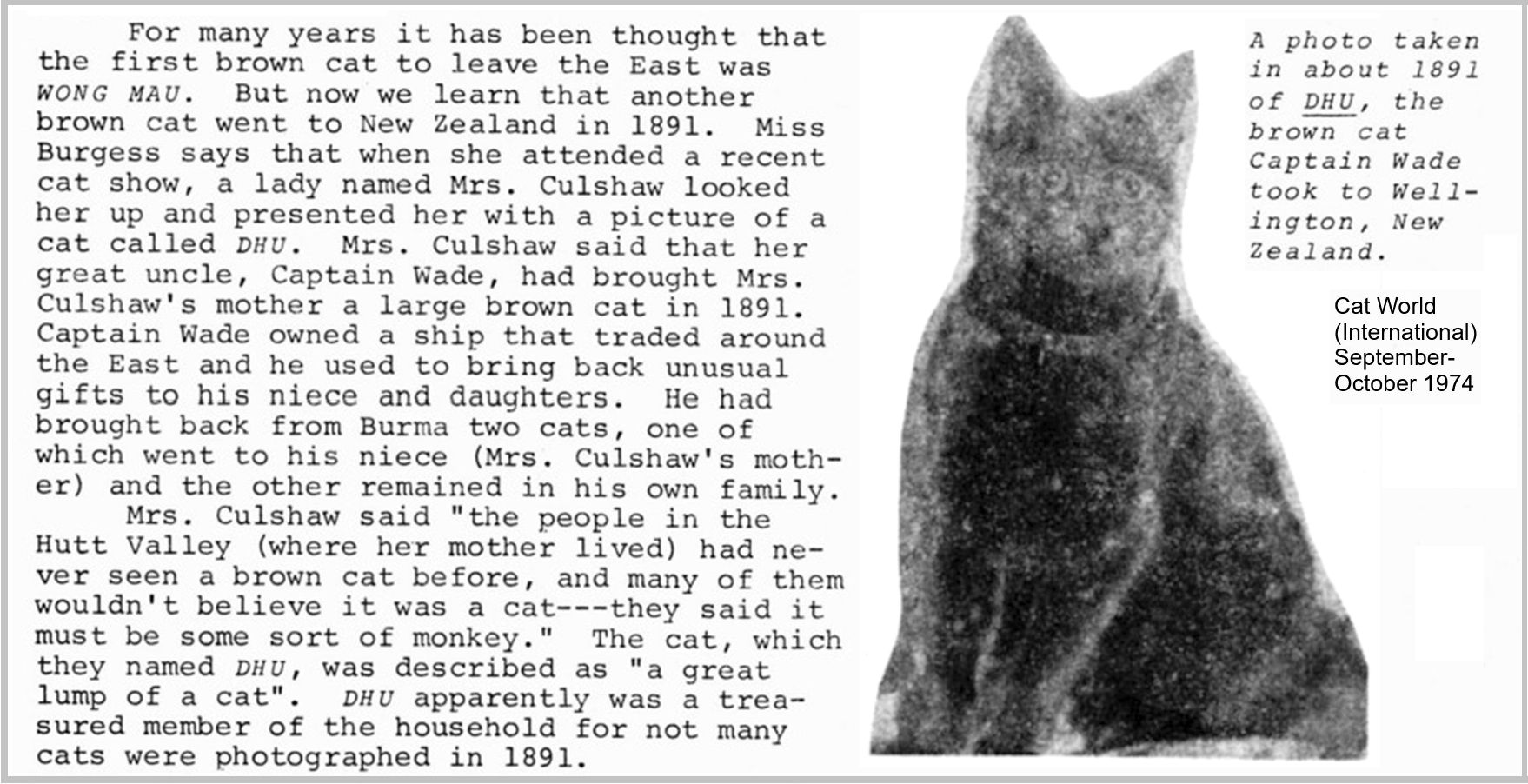
The modern Burmese breed traces to a cat imported into the USA in 1930. A single "copper cat" (called by the Thai people, Thong Daeng) named Wong Mau, arrived in the USA in 1930. Wong Mau was mated to a Seal-point Siamese cat, resulting in kittens of both Siamese coloration and those colored like their dam. This means Wong Mau was a mink-pattern Tonkinese. A male kitten was bred back to his mother, resulting in sable brown kittens that were darker than either parent. Thus began the Burmese breed.
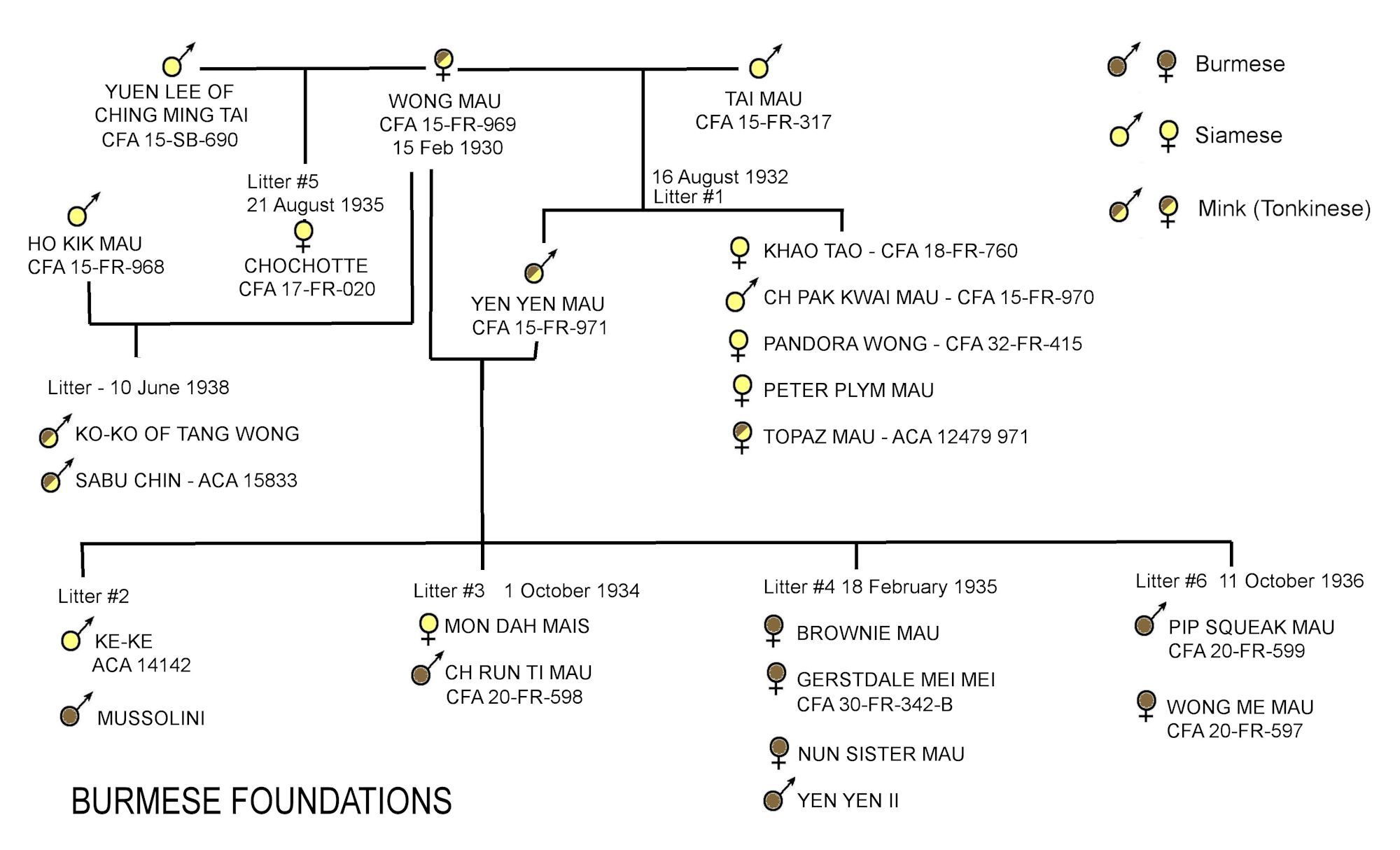
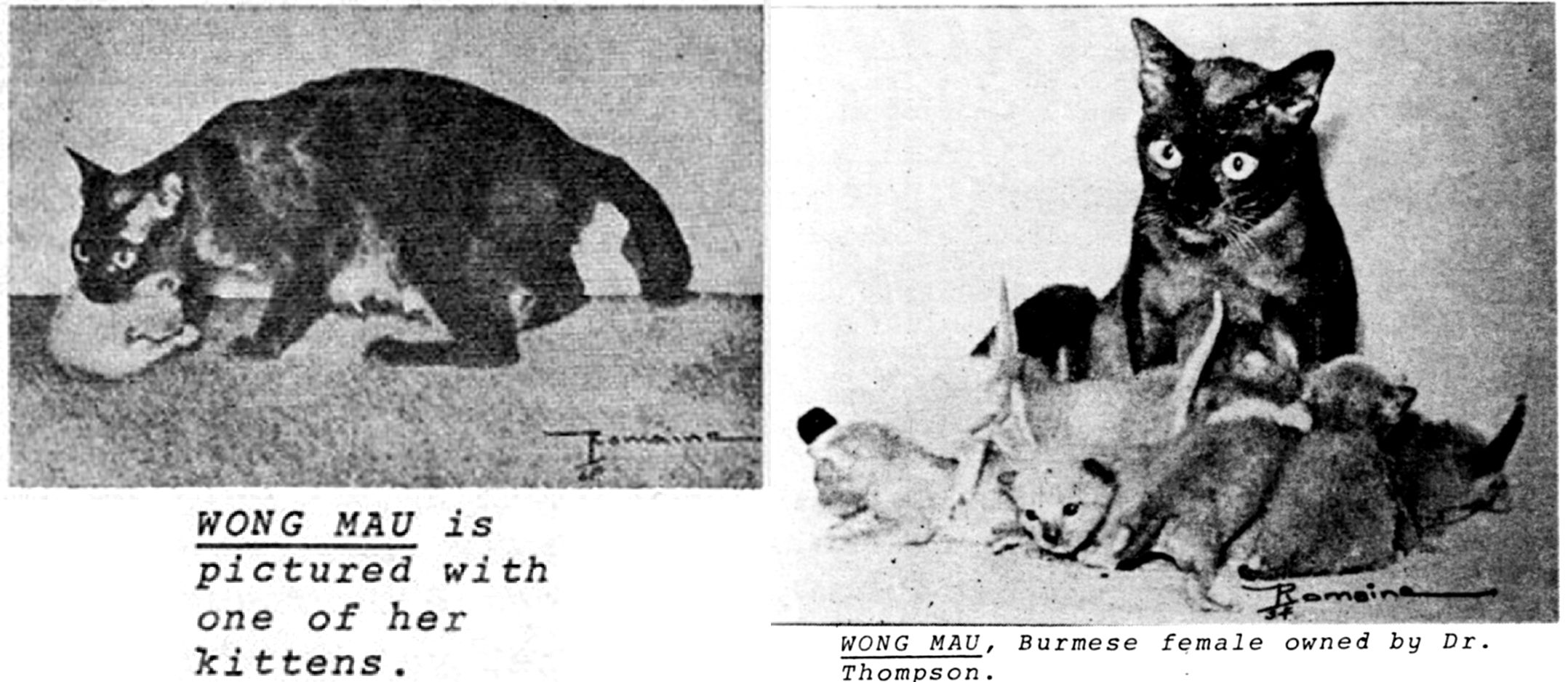
Early breeders bred Burmese to Siamese to avoid inbreeding. The American Siamese cat clubs opposed the new breed and Burmese vanished from the show bench in 1947. Breeding with Siamese created a more foreign-looking cat, losing the cobbier body and rounder head of the early cats. Additional Burmese were imported to strengthen the gene pool and the Sable (Brown) Burmese was recognised in 1957. Recessive genes in the gene pool gave rise to 3 additional colours. Blue, champagne (chocolate in Europe) and platinum (lilac) were initially registered as Malayan in 1979, but became part of the Burmese breed in 1984.
Two more imports were made into the USA in 1974 "Two rare native Thai Cats have been imported into the U.S. by Dr. Rosemonde S. Peltz and Mrs. Anne E. Bickman,; both of Atlanta/Georgia. The two kittens, Thaeng Daeng and Maha-jaya Chatopoh, were the result of four years of negotiations between Dr. Peltz and Mme. Ruen Rajniaitri of Bangkok. Rare even in Thailand, this breed which we call Burmese is known as the "copper cat." There, the chocolate fudge-colored cats are thought to be lucky and homes with one of them are considered very fortunate. All present Burmese in this country are descendants of Wong Mau, a cat imported from Burma by Dr. Joseph C. Thompson in 1930. Wong Mau was half Siamese and half "copper cat." She was bred to a Sealpoint Siamese and produced some Sealpoints and some cats, like herself. But, when her son was bred back to her, she produced brown-colored cats (the forerunners of the modern Burmese breed). Dr. Peltz, a member of the CFA board of directors, hopes the cats will be recognized by the association as Burmese, and subsequently provide another bloodline for the Burmese breed in the U.S. The two kittens will be on exhibition at the Atlanta Phoenix Cat Society's championship show on March 9 and 10, 1974. The show will be held at DeKalb College's gymnasium on Memorial Drive, east of 1-285 in Atlanta. (Pictured: Thaeng Daeng.)" (Copper Cats in Atlanta Cat Magazine, March 1974)
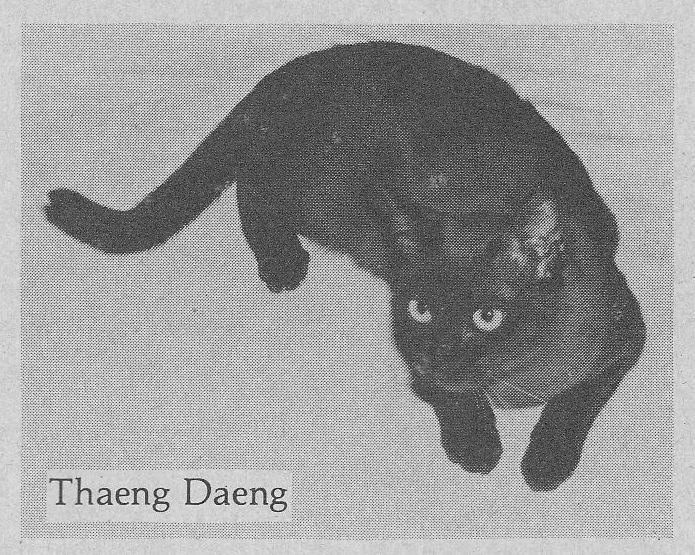
The Brown Burmese was recognized in the UK in 1952, being derived from US imports (although cats resembling Wong Mau had been brought back by soldiers stationed in the Far East during the late 1940s). Blue, chocolate and lilac colours soon followed. Continental Europe and the Commonwealth countries based their Burmese breeding programmes on cats from the UK so that the more foreign-looking European Burmese has become the prevalent type worldwide.
Red, cream and tortie Burmese were developed in the UK. In 1964, a Blue Burmese female accidentally mated with a red tabby shorthair. A second, deliberate mating was made between a Brown Burmese to a Red Point Siamese. A third mating was between a Brown Burmese male and a tortie-and-white farm cat with Siamese ancestry. The resulting red, cream and tortie range was recognised in the UK during the 1970s. Cinnamon Burmese were developed in Europe and New Zealand in the late 1980s and the 1990s. None of these colours are recognised in the American Burmese. Further outcrossing in Europe and Australia introduced silver, and tabby varieties of the four basic colors. In Europe, these became the Asian Shorthair breed group. Other colours are recognised under individual breednames e.g. the Bombay (solid black Burmese),the Burmilla (a silver tipped, shaded or smoke Burmese) and New Zealand s Mandalay (the other solid colours).
Although derived from cats imported from South-East Asia, the Burmese was developed in the west. The cobby and round-headed American Burmese breed is not recognised, even as an outcross, in Europe because of a lethal gene mutation carried by some lines. The oriental-looking European Burmese is the prevalent type around the world.
The American Burmese has a rounded head, relatively short nose, rounded eyes and cobby body with a broad and sturdy chest, short neck and thick tail
The European Burmese is a more elegant cat of foreign type (slender and angular) , with the head forming a short wedge and only slightly rounded. The eyes are slightly slanted and the neck is medium length.
The Singapura, despite early claims of Singaporean ancestry, is genetically indistinguishable from the American Burmese. It is essentially a small, fine-boned ticked-tabby Burmese derived from Burmese x Abyssinians crosses.
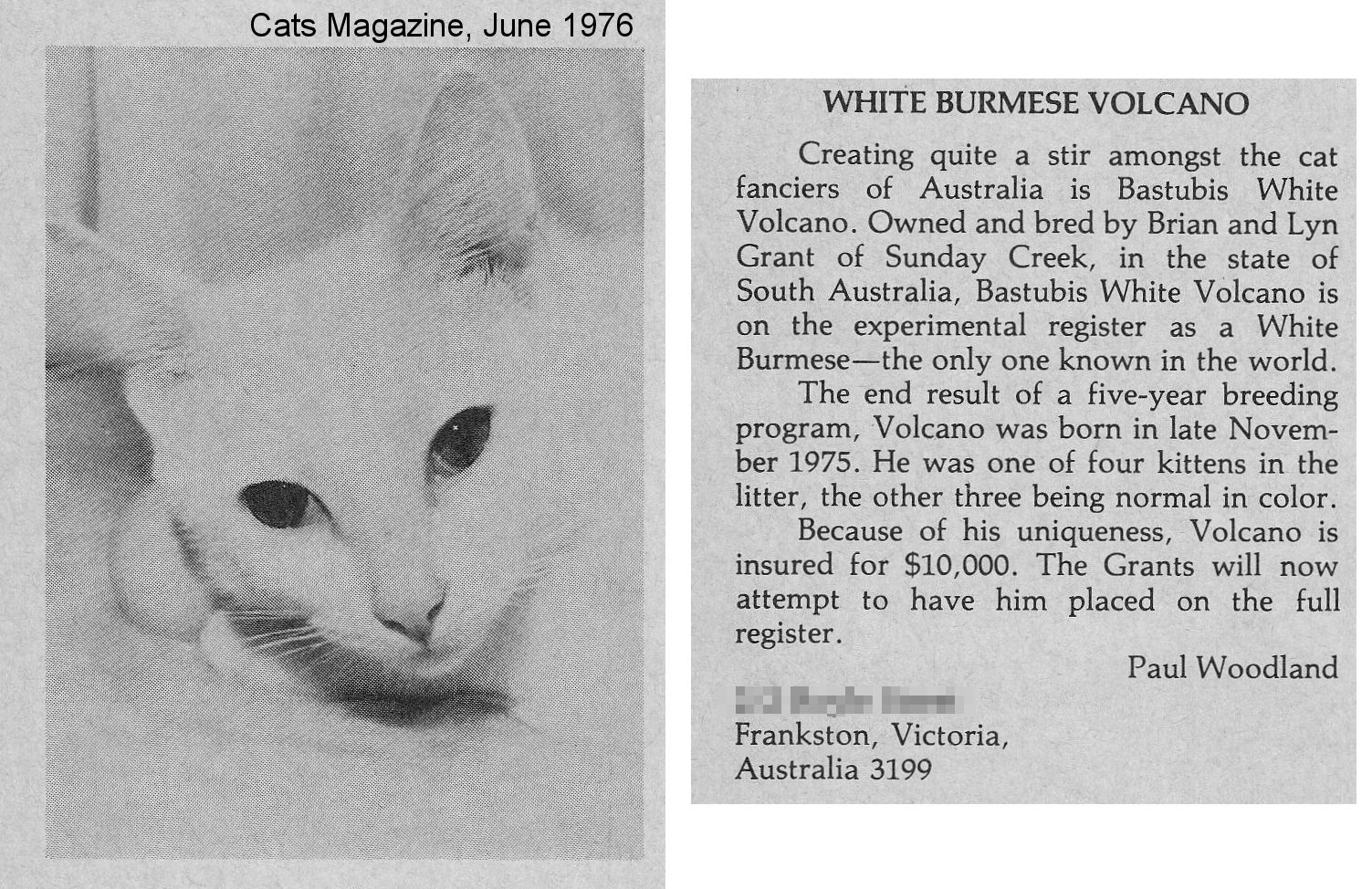
Burmilla
The Burmilla, which comes in both shorthair and semi-longhair versions, originated in the UK in 1981 with an accidental cross between a Chinchilla Persian and lilac Burmese. The kittens were attractive enough that a new breed was developed and gained recognition in the 1990s. It has the European Burmese conformation combined with the tipped, shaded or smoke pattern of the Chinchilla Persian. As a result of the crosses with silver Persians that were performed to develop the Burmilla, longhaired Burmese have been developed as the Tiffanie and Asian Longhair. The separate Australian Tiffanie is a cobbier cat with a greater amount of Chinchilla Persian blood than the European Tiffanie.
Bombay, Asian Shorthair and New Zealand Mandalay
The Bombay breeding programme began in the USA in the 1950s using black American Shorthairs and American Burmese to create a copper-eyed, jet black Burmese that resembled a miniature panther. It was recognised in the USA in the 1970s. Outside of North America, the Bombay conforms to European Burmese standards and is part of the Asian Self grouping (solid colour cats of the European Burmese type).
Digging around in old issues of Cats Magazine, we find the background of the Bombay in the August 1965 issue. "Shawnee" is the prefix of Bill and Nikki Horner of Kentucky. They bred, among other cats, American Burmese. The double page spread gave the real reason that a Black Domestic was crossed to the American Burmese and it was not to create a "fireside panther" it was to counter inbreeding depression in the American Burmese. What is interesting is the almost throwaway comment that it had been done before, but had not been made public knowledge. There had indeed been an accidental mating between a Black American Shorthair and an American Burmese. As well as trying to expand the gene pool, the breeder also noticed that the black Burmese hybrids were attractive and could be marketed in their own right. The links between the American Shorthair and the American Burmese is why the cranio-facial defect has shown up in both breeds. Here is the text from the advert:
"Burmese hybrids - BLACKS 3 Males, 2 Females, Born: 24 March 65 by Cassius [Grand Ch. Shawnee Cassius Clay] x Shawnee Eva 3rd generation black hybrid.
1 Sable Female 1 Black Male hybrids Born: 7 June 65. Cassius x Shawnee Delilah (daughter of Eva). The maternal Granddam was one of my Black Copper-Eyed stud book American Shorthairs. All other cats in my black hybrids breedings are Burmese. The purpose of these breedings is to breed a Burmese as the standard calls for and at the same time increase fecundity and offset lethal genes so evident in today's inbred Burmese. This has been done before to improve the Burmese shown today. I do not recall reading that it has been made public knowledge.
2 Black Proven Hybrid Females for Sale."
The European Bombay arose in two ways. Solid Black Burmese had occurred in Burmese litters in England as far back as the 1960s, but were not bred. The modern European Bombay began in the 1980s when Burmese breeders developed the self colour Burmese. American Burmese are not recognised for breeding in the UK (due to the craniofacial defect gene) so the breeders had to start from scratch. The sold colours were registered as the "Asian Self" and the Black Asian Self is also known as the Bombay. Kittens with Burmese colour restriction still occur in Asian Self and Bombay litters due to recessive genes and are registered as Asian Variants. The European Bombay breed was recognised in the UK in 1990, with other solid colours being recognised in 1994.
In continental Europe, Australia and New Zealand, new lines of European-style Bombay, were developed from local lines of European Burmese and black shorthairs. American Bombays have been imported into a few parts of Europe by those who consider the Black Self Asian Shorthair to be pretenders to the Bombay name. In New Zealand, the Asian Shorthair group is called the Mandalay with the black self Mandalay being analogous to the Bombay. The Mandalay began with accidental matings between Burmese and other domestic cats in the 1980s and were recognised in 1990. British-bred Bombays have also been used in some Mandalay bloodlines.
In all registries where it is recognised, to ensure the coat and conformation remains close to the Burmese, the Bombay is crossed to the Burmese.
The Asian Shorthair group in Europe includes tabbies, torties, smokes, shaded and tipped varieties. The tipped Asian Shorthair is recognised under the name Burmilla. Semi-longhaired varieties are recognised in Europe as the Asian Longhair group, also known as the Tiffanie (not to be confused with the Australian Tiffanie or the American Chantilly/Tiffany!). New Zealand's Mandalay are bred in solid colors and in tabby and tortie patterns.
BALINESE AND JAVANESE
These are the semi-longhaired kin to the Siamese and Oriental Colorpoint. Balinese and Javanese differ only in the colour of their points and in 2008 most registries merged these into the Balinese breed. Although semi-longhaired cats occurred in early Siamese litters, these breeds were developed in the USA.
The Balinese shares its early history with the Siamese imports into Britain in the 1870s and 1880s. Occasional longhaired kittens appeared in litters and some say that at least one Chinese tapestry depicts pointed longhairs. A more likely explanation is that the trait was introduced through early crossings with shorthaired domestic cats that carried the recessive longhaired gene. After many years of being hidden, a "Longhair Siamese" was registered with the Cat Fanciers Federation (USA) in 1928. They were not bred in earnest until 1955, and recognised in 1961, when two breeders in California and New York began exhibiting them. To keep them separate from the Siamese, they were dubbed "Balinese".
Balinese were recognised in the USA in the same range of colours as the Siamese: seal, chocolate, blue and lilac. Red, cream, tabby, tortie, cinnamon, fawn, smoke, silver and more were introduced through outcrossing to the Colorpoint Shorthair. Most registries accepted these as Balinese, but until 2008, the CFA recognised the newer colours as Javanese. Some registries also accept Bicolour-point Balinese.
Balinese are crossed with Siamese to maintain the conformation. This means they too have changed from chunkier cats with rounder heads to tubular, long-headed cats with large ears. However, crossing to the Siamese affected the Balinese's fur and many resemble a Siamese cat with a plumy tail rather than a semi-longhaired cat. The fur should be silky and one to two inches long, with a plumy tail.
In the USA during the 1960s, Siamese cats were crossed to red Turkish Angoras to create a colourpointed, semi-longhair breed called the Singhalese. These were fluffier and less vocal than the Balinese, but were judged to the Balinese standard (with allowances made for its different coat type). The Singhalese breed soon vanished.
Note: Outside of the USA, "Javanese" may refer to non-colourpointed relatives of the Balinese i.e. Oriental Longhairs.
HAVANA (HAVANA BROWN & LILAC HAVANA)
Solid brown cats were among the varieties described in the Tamra Maew and, along with the "Royal Siamese", were imported into Britain. One of those solid brown cats, Granny Grumps, was bred with Siamese and produced many Siamese patterned kittens, which means she carried the colourpoint gene. It s not possible to be certain, but they may have represented early examples of the Havana Brown and Chocolate Oriental Shorthair.
In the 1930s, there was renewed interest in solid-colour Siamese-type cats. Between the two World Wars, low numbers meant breeders had resorted to crossing Siamese, Burmese and Russian Blues just to keep bloodlines going. In the 1950s, British breeders produced chocolate (chestnut) colored kittens through mating a black shorthair and a chocolate point Siamese, recreating a type of cat abandoned in the 1920s. The GCCF accepted the name "Havana" in 1971, but English Havanas differ from American Havana Browns. FIFe recognises the English Havana as the Chocolate Oriental Shorthair. Its conformation is the same as the Siamese and other Oriental Shorthairs.
The Chestnut (i.e. Chocolate) Brown Oriental was exhibited in the United States in 1959 and developed to be very different from the Oriental Shorthair in the UK. The American version was named the Havana Brown, because its colour resembled that of a Havana cigar or Havana rabbit.
The American Havana Brown is distinct from the Siamese and Oriental. It has a less extreme semi-foreign conformation and a characteristic boxy muzzle. This is believed to reflect the look of the original foundation cats imported into the USA. This Havana Brown is not recognised in Britain or Continental Europe.
To counter a harmful degree of inbreeding, some registries allow Havana Browns to be outcrossed to Oriental Shorthairs (excepting colourpointed, fawn or chocolate varietes) and to solid black and solid blue domestic shorthairs. Until the 1970s, some North American breeders outcrossed to Russian Blues and Siamese. As a result of outcrossing, lavender (lilac) Havanas with pinkish-grey coats sometimes appear and are accepted as variants by some registries. In 1983, TICA changed the breed name from Havana Brown to Havana, but moves to merge the Havana into the Oriental Shorthair group were resisted because of its distinctive look.
KORAT (SI-SAWAT), THAI POINTED AND THAI LILAC
Korat was the unofficial name of the former Thail capital. In Thailand this breed is known as the Si-Sawat Maiow. It was first introduced to the cat fancy at am English cat show in 1896 as a "Blue Siamese", but did not achieve breed recognition for over half a century.
This silvery cat was described in ancient Thai poems as the colour of clouds with eyes like dewdrops on the lotus leaf. Visitors to Thailand in the early 20th century who asked locals about their famous "Siamese cats" were these solid blue cats, not the seal-point cats they expected. Korats could not be purchased, but could be given as gifts to Thai dignitaries. Some were bestowed upon foreign dignitaries as an expression of highest honour. Korats were supposed to bring a good harvest and played a role in rain-making ceremonies at the end of the dry season when they were carried in procession to have water sprinkled on their fur. Traditionally, a pair of Korats was given to a bride on her wedding day to ensure future prosperity. On the other hand, male Korats were supposedly taken into battle on the shoulders of warriors and would launch themselves fiercely at the enemy.
From a very few imports, the gene pool for the Korat breed was developed in the 1920 s through crossing to imported, rather than domestically bred, Siamese cats. Due to the presence of breeding programs in Thailand, more imports followed in subsequent years. Unlike the Siamese and Burmese, the Korat has remained true to its ancestral conformation.
Frances Simpson's "The Book of the Cat" (1903) recorded a Blue Siamese purchased by famous Russian Blue breeder, Mrs Constance Carew-Cox in 1889. This cat, "Dwina" resembled a (traditional style) Siamese in all ways except for her solid blue colour. Recorded as a Siamese, Dwina was shown in the "Any Variety" mixed classes, winning many prizes and producing many kittens.
In 1896 a Blue Siamese called "Nam Noi" was exhibited at Holland House, London. He was variously described as a Siamese or a Russian Blue, and was registered with The National Cat Club as a male Siamese of unknown parentage imported by Mrs B Spearman in January 1895. While there was no doubt that Nam Noi was a Siamese in every detail apart from his colour, he was disqualified from the Siamese class because he was not a Seal-Point, and was instead awarded first prize in the "Russian or Any Other Blue Cat" class. According to WR Hawkins in the July edition of Around the Pens: " Nam Noi, a Blue, was entered as a Siamese, and very possibly came from Siam; but that does not make him a Siamese any more than an English cat coming from Persia would be a Persian. To my thinking, Nam Noi was an undoubted Russian. [...] In Russians Nam Noi in its right class won." With no knowledge of the variety of cats to be found in Asia, western cat fanciers had decided that a blue cat from Siam could only be a Russian Blue.
Nam Noi's owner tried to import more Blue Siamese. According to a Briton in Thailand: "A friend [...] confirms the existence of the Blue Siamese, as she herself possesses no fewer than eight Blues, and says they are quite common on the Burmese frontier, where they are called Shan cats, as belonging to the Shan tribes". But no more was heard of the solid Blue Siamese. These were probably the first Korats exhibited at a British cat show.
In 1959, the Korat breed finally arrived in the west when two cats were presented to the American Ambassador to Thailand. He sent them from Bangkok to Mrs Jean Johnson in the USA. She had been attracted to these cats during a visit in 1947, but had not been able to obtain any. More were imported into the USA during the 1960s. To be considered authentic Korats, they had to have a pedigree traceable to cats in Thailand. In 1966, the breed gained recognition. The Thai spelling, Koraj (the province these cats came from) was changed to Korat by European breeders reflecting its sound to Western ears. Korats didn't return to Britain until 1972 and achieved recognition there in 1984.
Cat fanciers stipulated the blue-grey colour in the Korat breed standard, but the breed naturally produced lilac (lavender) point kittens right from the start in the USA. Most breeders considered this a sign of impure bloodlines. In 1989, two Korats in the UK produced a "pink" kitten. During the 1990s, other Korats in Britain produced white kittens that developed into blue-pointed cats, and "pink" kittens. These colours were due to recessive genes that existed in Korats in their native country.
In the UK, these variants could not be called Lilac Korats or Blue Pointed Korats because the Thai name specifically means a blue cat. To respect both Thai tradition and the cat fancy s requirements, the names Thai Blue Pointed and Thai Lilac were chosen (Thai Lilac Pointed may eventually appear). They gained recognition with the GCCF in 2002. Thais are simply Korats in different colour coats and it is left to individual Korat breeders whether they wish to include or exclude these cats in their Korat bloodlines.
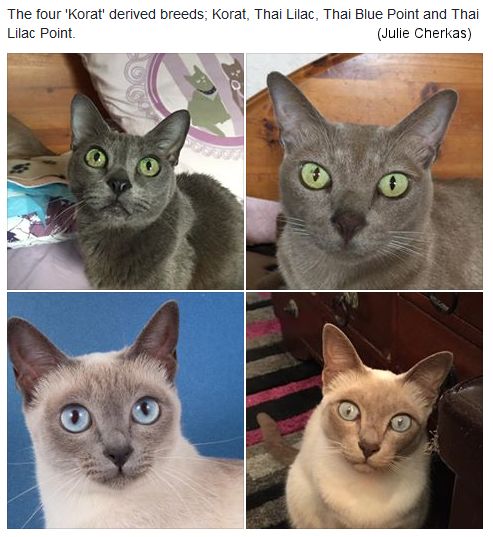
The Korat is a small-to-medium-size but substantial cat, with large, round, luminous green eyes in a heart-shaped face. Its short silvery-blue coat is delicately tipped in silver, known in its homeland as "sea-foam". The Thai Lilac and Thai Pointed have the same physical conformation as the Korat. The Thai Lilac is warm pinky-beige colour, tipped with silver and having the characteristic green eyes. The Thai Blue Point differs from the Korat only in the eye colour and coat pattern; its blue points have the characteristic silver tipping. Being family oriented, the males of these breeds are said to be good fathers if left with their kittens.
ORIENTAL GROUP (ORIENTAL LONGHAIR, ORIENTAL SHORTHAIR, MANDARIN)
The Oriental Shorthair is a non-pointed Siamese. Similar cats were described in the Tamra Maew, but the showbench version is tubular, long-headed and large-eared. Exhibition Oriental Shorthairs differ from native Thai cats in the same way that the exhibition Siamese differs from those found in Thailand. The Balinese is a semi-longhaired form of Siamese, and the Oriental Longhair is a non-pointed Balinese.
Cats equivalent to black and blue Orientals were bred in Germany before World War II, but the Oriental Shorthair breed originated in England after the war. With so many bloodlines lost and the number of pedigree cats severely reduced, different breeds were crossed in order to increase numbers and decrease inbreeding. Siamese cats were crossed to Russian Blues, British Shorthairs and Abyssinians resulting in non-pointed offspring. These were bred back to the Siamese to give colourpointed cats and regain the Siamese conformation. A side-effect of crossing to other breeds and back-crossing to Siamese was the emergence of "non-pointed Siamese". These became a breed in their own right . Crossing Russian Blue, Abyssinian and Siamese produced the Ebony (Foreign Black), Chestnut Foreign (Chocolate Oriental/British Havana) and Lavender (lilac) Foreign. These were registered as Foreign Cats with the GCCF in 1958.
Further crossing of Siamese cats with other shorthairs resulted in yet more colours in both pointed and non-pointed forms including the Foreign White, the Havana and the Oriental Spotted Tabby. In general, solid colours became Foreign Shorthairs, while the tabby patterned cats became Oriental Shorthairs. Eventually, they were all grouped as Oriental Shorthairs while the longhaired version became the (British) Angora.
Oriental Shorthairs were imported into North America in the 1970s and further bloodlines were developed there using American Shorthairs and Siamese. The British Havana (Solid Chocolate Oriental, or Chestnut Self Oriental in Europe) was developed into a very different breed called the Havana Brown in the USA. The Oriental Shorthair gained championship status in the USA in 1977 and the Bicolour Oriental Shorthair was recognised in 1985. In Europe, the Oriental Bicolour is recognised separately from the Oriental Shorthair/Longhair in order to prevent white spotting from entering the Siamese and Balinese breeds. The White Oriental Shorthair (Foreign White) is due to the dominant white masking gene. Some are genetically colourpointed (and thus have blue eyes), but this is masked by the white gene. Other White Oriental Shorthairs have green, blue, or odd-eyes and are genetically non-pointed cats. The White Oriental Shorthair is also distinct from the unpigmented Albino Siamese which has light-sensitive pinkish-blue eyes.
In the late 1960s and early 1970s, a British breeder crossed a Sorrel (Red) Abyssinian and a Seal Point Siamese. When two of their offspring were mated together, the Oriental Cinnamon (Shorthair) was created in 1971. The Abyssinian sire also carried the gene for longhair and in 1973 a "Longhaired Havana" was born, becoming the British "Angora" in 1998. At that time, the authentic Turkish Angora was not recognised in the UK. In June 2003, it became the Oriental Longhair (solid colours sometimes being called Foreign Longhairs). Other cat registries recognise it as the Mandarin or Javanese. In the USA, the Oriental Longhair has different origins, resulting from an accidental mating of an Oriental Shorthair and a Balinese in the late 1970s and was recognised as a breed in 1985. As with the Siamese and Balinese breeds, the Oriental can be found in both the extreme version and in a more moderate "traditional" style.
The Seychellois, or Bicolour Oriental, is a bicolour-point Siamese developed in Britain in the 1980s through crossing a tortoiseshell-and-white Persian to a Siamese. It is recognised by FIFe in both longhair and shorthair forms. Previously, the name Seychellois had been applied to Van-Pattern Oriental Shorthairs. FIFe's breed standard describes the Seychellois Shorthair/longhair as a Siamese or Balinese with white patches. The separate breed names is to prevent white spotting entering the Siamese or Balinese gene pools.
The recessive colourpointing gene can be carried by Oriental Shorthairs and Longhairs. Some registries class colourpointed progeny of Oriental Shorthairs as "Any Other Variety" (AOV) or Colorpoint Shorthair while others class them as Siamese (and likewise for Oriental Longhairs and Balinese). Many registries allow the inter-mating of Oriental Longhairs, Oriental Shorthairs, Siamese and Balinese and register the offspring according to appearance (long or short fur, colourpoint or non-colourpoint). Other registries do not allow "variants" (e.g. colourpoint offspring born to solid colour parents) to be registered or exhibited in a different class. Crossing the breeds maintains their identical conformation and temperament, allows new bloodlines to be created and ensures genetic diversity.
Over 300 colour and pattern combinations are possible in the Oriental group. The solid colours are white, red, cream, black (ebony), chocolate (chestnut), cinnamon, fawn, blue, lavender (lilac/frost), caramel and apricot. Tortoiseshells (parti-colours) also occur. All of these can occur with white to give bicolour and van-pattern cats. These can be combined with silver or golden to give smoke, shaded, tipped and silver or golden tabbies. The tabby patterns are mackerel, classic, spotted and ticked. Not all registries recognise chocolate, lavender (lilac), caramel, apricot or tortie-tabby (torbie) Orientals. Some recognise bicolours as a colour division of the Oriental Shorthair/Longhair breeds while others recognise them as separate breeds. The sepia (Burmese) and mink (Tonkinese) patterns are not currently recognised in Orientals.
TONKINESE (Golden Chechong, Golden Siamese, Si-Burm)
There are two naturally occurring gene mutations that produce colourpointing. One produces the Siamese pattern when two copies are inherited. The other produces the Burmese pattern when two copies are inherited. If a cat inherits one copy of each gene, the result is intermediate between the two patterns known in the cat fancy as the mink pattern. When bred together, mink Tonkinese also produce colourpointed variants and Burmese-pattern variants as well as mink pattern cats, however these do not have the conformation of either the Siamese or Burmese and are registered as variant or non-standard Tonkinese. The interbreeding of the two patterns is common in Thailand, but the selective breeding programmes of 20th century cat fanciers concentrated on the Siamese and Burmese, diverging these into two very different-looking breeds. Had things been different, we might have had the Siamese, Tonkinese and Burmese patterns in a single moderately foreign breed.
Nineteenth century descriptions show that all three varieties, with their different eye colours, along with early Korats, were imported into Britain and termed "Siamese". The foundation cat of the Burmese breed, the walnut-brown Wong Mau, along with some other early "Chocolate Siamese" imports, were genetically natural (brown) mink. In the 1930s, Wong Mau produced both pointed and mink pattern offspring when mated to a seal point Siamese. This meant she had carried the genes for both the Siamese and Burmese pointing patterns and was a naturally occurring Tonkinese.
The popularity of "in-between" patterned cats between the 1930s and 1950s were an obstacle to the development and acceptance of a "pure" Burmese breed in the USA. Some Burmese breeders continued to use mink pattern cats in their breeding programmes while others destroyed the cats because they did not breed true. In the 1950s a New York pet shop owner crossed Seal-point Siamese with Brown Burmese for several generations and sold the "Golden Siamese" progeny as pets. These Golden Siamese were popular pets during the 1950s and 1960s, but he later discontinued breeding them.
In the mid-1960s, a breeder in New Jersey, USA and another in Canada, independently crossed American Burmese to Siamese cats. Both produced a line of brown cats, with darker points and aquamarine eyes. They later combined their breeding programmes under the name "Tonkanese". They called the brown pattern "natural mink" and it was later joined by blue and honey varieties. The "Tonkanese" was recognised by the Canadian Cat Association (CCA) in 1965. In the 1970s the breed was renamed Tonkinese and gained wider recognition in North America. The name "Tonkanese" alluded to a fictional island in the musical South Pacific where "half-breeds" were not discriminated against. Tonkinese suggests the Tonkin region of Indochina, not far from Thailand (Siam) and Burma.
In the UK, the Tonkinese was recognised in the 1990s. In Europe, FIFe does not yet recognise it, so European breeders instead register their cats with TICA. During the 1990s in Australia, the Tonkinese faced serious opposition from Siamese and Burmese fanciers because it was a "crossbreed" and did not breed true.
Although there is now sufficiently large established gene pool that outcrossing to Siamese and American and/or European Burmese is not strictly necessary, many registries permit it. Where outcrossing is prohibited, the Tonkinese tends to produce smaller litters. The breed is believed to be clear of the lethal head defect gene carried by some lines of American Burmese.
Formerly dismissed as a "poor quality Siamese", the mink and pointed Tonkinese appeal to those who prefer the older, less extreme, style of Siamese. The solid Tonkinese variant resembles the early Burmese, being more foreign in conformation. North American standards call for substantially built, strong cats. European standards call for medium build and foreign type. These differences result from differences between the European Burmese and the cobbier American Burmese. In Australia, breeders have combined Australian, New Zealand, North American and British/European bloodlines outcrossed to American Burmese to create their own "Australian Tonkinese". Tonkinese are not simply crossbreeds. They have a look and character all of their own and represent a modern Western recreation of an ancient Asian variety.
The three Tonkinese patterns are mink (preferred for exhibition), solid (Burmese pattern) and pointed (Siamese pattern). Mink Tonkinese have shaded "points" that are a darker version of their body colour; having less contrast between body and legs than the Siamese, but more contrast than the Burmese.
In North America, only the four basic colors, seal (or Natural), chocolate (champagne), lilac (platinum), and blue are recognized. Elsewhere, depending on the registering body, it is recognised in brown, blue, chocolate, cinnamon, lilac, red, cream, blue-based caramel, lilac-based caramel, apricot and in the tortoiseshell, tabby and tortie-tabby (torbie) versions of those colours. This wider palette is due to the wider range of colours inherited from the European Burmese. The eye colour is linked to the coat colour: solid Tonkinese having gold or golden-green eyes; minks having aqua eyes; pointed Tonkinese having shades of blue.
On average, mink-to-mink matings produce 50% mink kittens, 25% pointed and 25% solid. Solid-to-pointed matings produce only mink kittens. Mink-to-solid produces 50% mink and 50% solid. Mink-to-pointed produces 50% mink and 50% pointed. Though considered pet quality by most registries, the pointed and solid Tonkinese variants inherit the same conformation and charming personality as their mink pattern brethren. It also combines personality traits from both parent breeds.
Over the decades, several names have been proposed for semi-longhair Tonkinese. Thus far, only the Tibetaan and Tonkinese Longhair have gained any form of recognition.
MEKONG BOBTAIL (Thai Bobtail)
While the British cat fancy eliminated short-tailed and kink-tailed Siamese from their breeding programmes, Russian breeders embraced the colourpointed bobtails.
In the late 19th century Nicholas II, Tsar of Russia received a number of "Royal" cats from the King of Siam Chulalongkorn, Rama V. Many of these had short, kinked tails. Along with later imports, including cats from Vietnam, these were the foundation cats for the Mekong Bobtail. It is not outcrossed with any other cats.
In many respects it differs from the Thai (which resembles the older style Siamese) and may not be outcrossed to the Thai. Unlike modern Siamese it is rectangular rather than tubular. It is medium sized, well-muscled, but elegant with a short curved tail. The head is a slightly rounded wedge like that of the old style of Siamese. The eyes must be blue. All colourpoints are permitted, but must not have any white spotting. The fur is short, glossy and close-lying, is thin but not silky. There is a noticeable undercoat.
The distinctive feature is the tail: it should be no longer than one quarter of the body length and should be flexible despite having one or more kinks or curves. Shorter tails are preferable, but should not be less than 3 cm long. Its tail is short with varying combinations of kinks or curves. It must have at least 3 vertebrae. Long-tailed cats are not eligible for exhibition.
The Mekong Bobtail is named after the Mekong River bordering Thailand. Colourpoint bobtails occur naturally in Thailand, parts of Russia and in the southeast of Asia. Between 1997 and 2004, it was known as the Thai Bobtail. It was renamed Mekong Bobtail to avoid confusion with the already recognised Thai. By 2012 there were around 1,500 Mekong Bobtail cats registered with cat clubs in Poland, the Czech Republic, Russia, Belorussia, Latvia and Germany.
KHAO MANEE or KHAO PLORT
Some Thai texts referred to an "all-white" cat called Khao Plort, but with no mention of eye colour. The odd-eyed "Khao Manee" appears to have been developed independently of the poems, but is nonetheless a popular Thai cat. Khao Manee means "white jewel". It is also known as the "Diamond Eye Cat" because its eyes have a peculiar brilliance. Some have same-colour blue eyes, some are blue/yellow odd-eyed (preferred) or blue/emerald-green odd-eyed, while others have eyes of different shades of blue. Some Khao Manee are born with dark smudges on the head. These disappear with age and indicate that the white colour is due to extreme expression of the "white spotting" gene and not the "white masking gene". It is shorthaired, though the coat is slightly longer than that of the Burmese. As with other blue-eyed white cats, the Khao Manee may suffer from deafness. Its white ears may be affected by skin cancer.
The Western concept of the Khao Manee is a muscular, athletic cat of moderately foreign type that was reputedly once exclusively bred by Thai royalty. Many of the cats exported from Thailand had kinked tails. It was recognised by TICA in 2009 and by the GCCF in 2010, but has not yet advanced to championship status. As a recent import, the conformation remains true to its Thai ancestors. Numbers of Khao Manee in Thailand appear to be in decline.
MADURA or KUCING BUSO (RA'AS CAT)
The Madura or Buso cats are a closed colony of bobtailed blue cats with green eyes which live on the tiny and isolated island of Ra'as about 15 km off the coast of the Indonesian island of Madura (it is a 6 hour ferry ride from Madura to Ra'as). There are reckoned to be less than 100 of these cats and they are in danger of extinction, in part due to local beliefs that prevent the exportation of fertile cats. The Madura breed and its decline have been documented by Lesley Morgan and Dr Ronny Rachman Noor (Faculty of Animal Science, Bogor Agricultural Universtity). The cats are known to the islanders as "Kucing Buso" (ashy grey cat) and the true Madura cat is blue self, suggesting they may have come from Korat (to use the Thai system of classifying their native breed - blue-grey Maew Boran) stock taken to the island on trading ships. Some are a cinnamon colour and are known as Kucing Kecubung.
The discrepancies in descriptions from different sources result from differences in how natural Thai and Indonesian cats are classified in the Western system and the Thai system. In addition, the cinnamon colour may not be the same as genetic "cinnamon" seen in cat fancy Orientals.
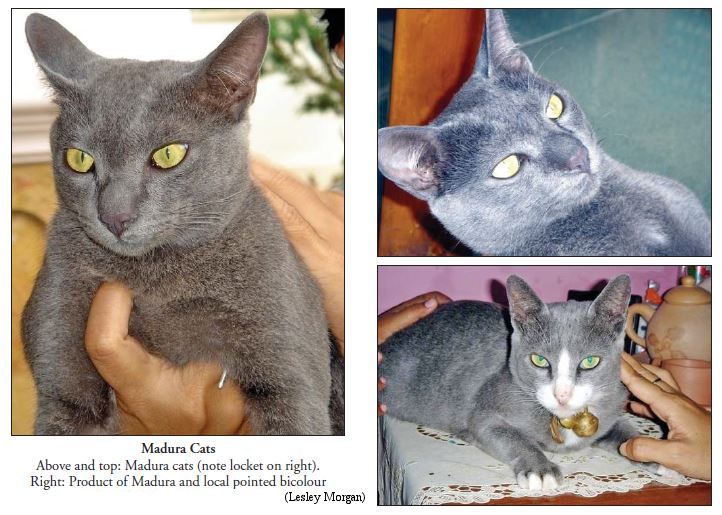
Early reports described the cats' posture and the triangular facial shape as being similar to the wild cat and leopard, but later reports and photos don't bear this out. The early reports also described the cats as large, though they are actually medium-sized, with a medium length tail with a visible bend or kink at the end. The fur has been described as relatively thick, but cats seen in 2016 had body-hugging single fur. The true Madura cat is solid grey (although low-grade white spotting on the belly is common) known as "buso" often with lavender nose leather. They are most likely inbred descendants of Si-Sawat cats.
Some of the cats on Madura have with the brown sepia, mink, mocha and colourpoint patterns as well as blue bicolours due to mating freely with local cats. A brown mink "Madura cat" exhibited at a cat show in Surabaya was of Japanese Bobtail type.
There is some mythology surrounding the breed, just as there was about the "Royal Siamese". The true Madura cat, originating from Ra'as, may only be kept by high-ranking people such as religious leaders, high rank government officials and informal leaders. Anyone attempting to smuggle a cat from Ra'as will find their boat sinking. Cats brought out from Ra'as were castrated due a local belief that the fertile Buso cat may only be kept at the Ra'as island (castration in itself may pose dangers of infection). The lure of having a local breed, however, has overcome much of the superstition about exporting the cats, but the high mortality rate and physical peculiarities indicates poor immune systems due to inbreeding depression.
To preserve this cat as a distinct type and avoid extinction, breeders would need to establish breeding lines which would mean obtaining unneutered cats. The restriction on who may own a true Madura cat also limits ownership and controlled breeding, though the idea of a local breed has largely overcome that obstacle. The declining numbers appear due to people trying to export the cat out of the island and to the high mortality rate among breeding cats, both on Ra'as and on Madura, suggesting a high degree of inbreeding and internal parasitism. The cats that are exported are in serous need of fresh blood (the Thai Si-Sawat is the obvious candidate) to reverse the inbreeding problems, but the desire to have a "pure" breed means the exported cats end up being further inbred on the mainland!
In August 2015 I received a number of pictures of Madura cats from Didy who lives in Jakarta, Indonesia. Lesley Morgan had already seen one of the bobtailed Kecubung (mink) variants and Didy and two friends provided additional photos to Lesley and myself to help identify Madura cats. All of these cats came straight from Ra'as Island. One resembles Burmese, one resembles a Korat, one looks like a Tonkinese (mink) and the fourth looks like a traditional style Siamese. All four have kinked tails and live in Bogor. A further photo shows a Busok/Buso (Korat-like) female with 4 kittens. One of the the kittens looks like a colourpoint. The male parent was also a Busok cat. Both parents have long (normal) tails. These cats live in Sumenep, Madura, near Ra'as Island.
After 2018, I have not heard anything further from Didy, who provided me with photos and some of the information.
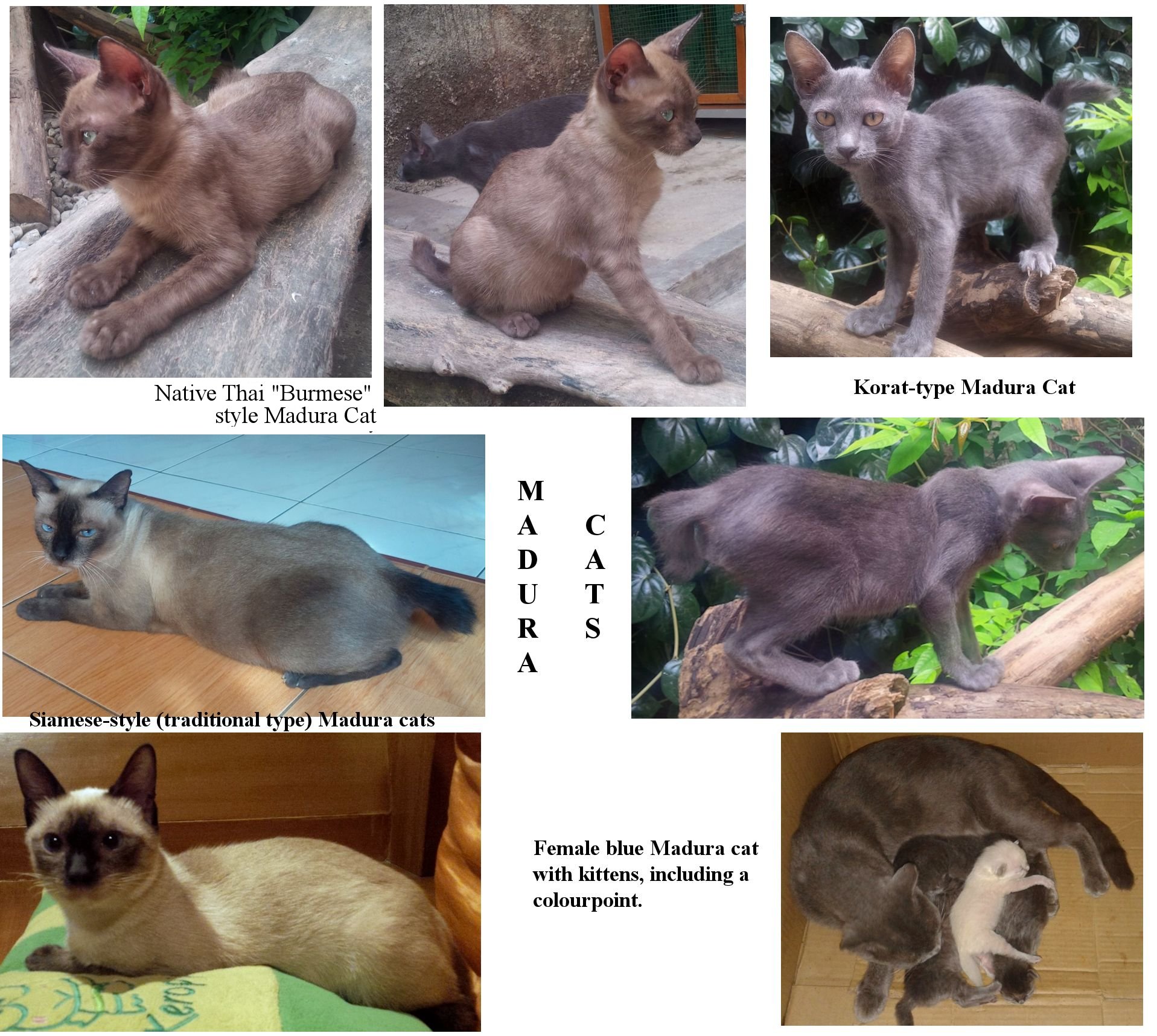
PIAWAIAN KUCING MALAYSIA (MALAYSIAN PIAWAIAN CAT)
The Kucing Malaysia breed began in 1994 and owes its existence to Mrs. Alva Uddin. It has been described as "similar in type to the Tonkinese, similar in colour to the Ragdoll." Almost everything about it is described as "medium". It has not yet been picked up by the western fancy. Its temperament is similar to the Bengal - loving and playful making it a good family cat.
It is a medium-sized, medium-boned shorthaired cat with a muscular body and broad chest. Its head is medium-long and egg-shaped; wide and rounded at the top with soft, round lines rather than the angles seen in Western interpretations of oriental cats. It has open, alert almond-shaped blue or blue-green eyes and forward-tilting medium sized ears with slightly rounded tips. Unlike the exaggerated ears of the Orientals, the Kucing Malaysia s ears flare only a little. It has a short, silky, close-lying coat with little or no undercoat. It s tail, unlike the whippy tail of exhibition oriental cats, is thick and medium length with a rounded tip.
The Kucing Malaysia was supposed to have been bred in pointed patterns containing white and should have a white blaze on its face and muzzle. The points may be any of the traditional Siamese colours, plus the red series and can be solid, tortie or tabby, and must include white markings on the paws and legs. It never took off in a serious way. One breeder used a silver tabby Exotic with the Kucing Malaysia. The problem was, the semi-longhairs were rather similar to Ragdolls and the shorthairs resembled Snowshoes, making it easy to understand why the Kucing didn't gain a following.
Another proposed Malaysian breed, called the Malaysiana, was reported in magazines in 1996 (when FIFe s GA was held in Kuching and it was decided to promote a wholly Malaysian breed, an initiative backed by Mrs. Alva Uddin). This resembled a small tiger with mackerel striping and athletic, moderate, Abyssinian-like type. The Malaysiana really only existed in the imagination of the FSM (Malaysian cat fancy) committee and was to have been Malaysia's answer to the Singapura, and just as fabricated in its origins. Australian judge Lesley Morgan and British judge Anne Rickson were consulted on how to create a mackerel tabby that could be claimed as unique to Malaysia. The FSM standard was more or less that of a pet quality British black mackerel tabby. Morgan and Rickson suggested that a bicoloured bobtail would be much more typical of Malaysian cats (and much later, the Mekong Bobtail was developed).